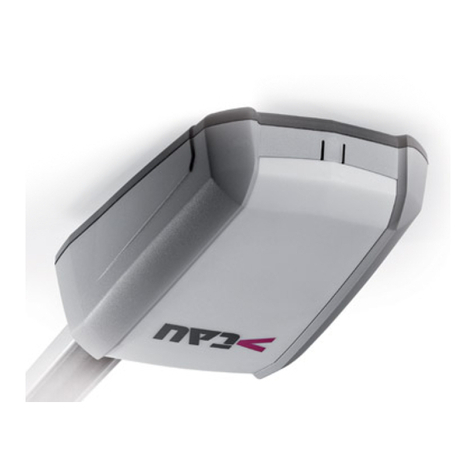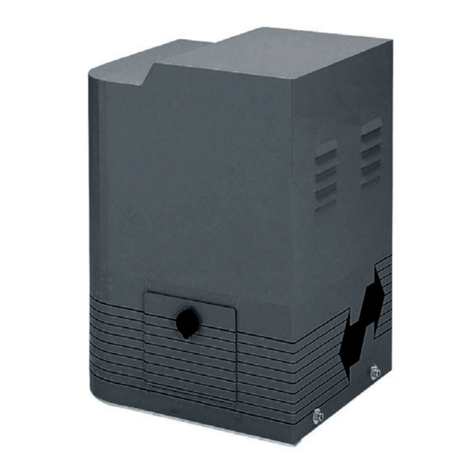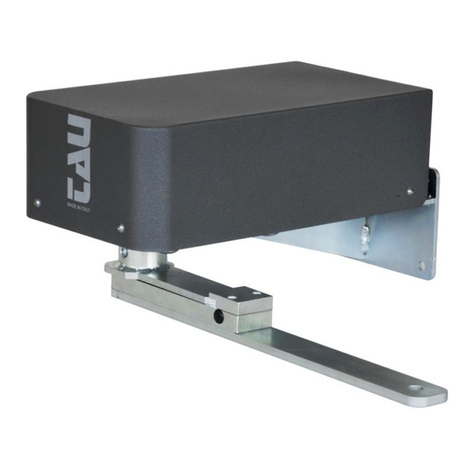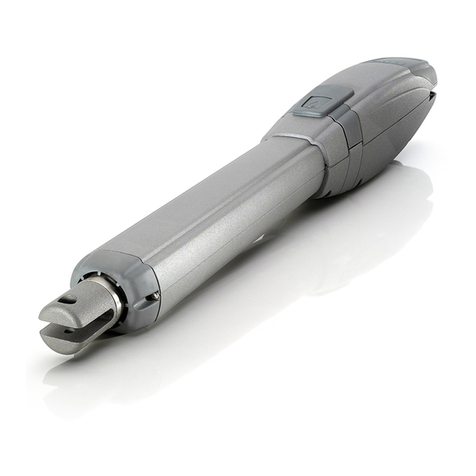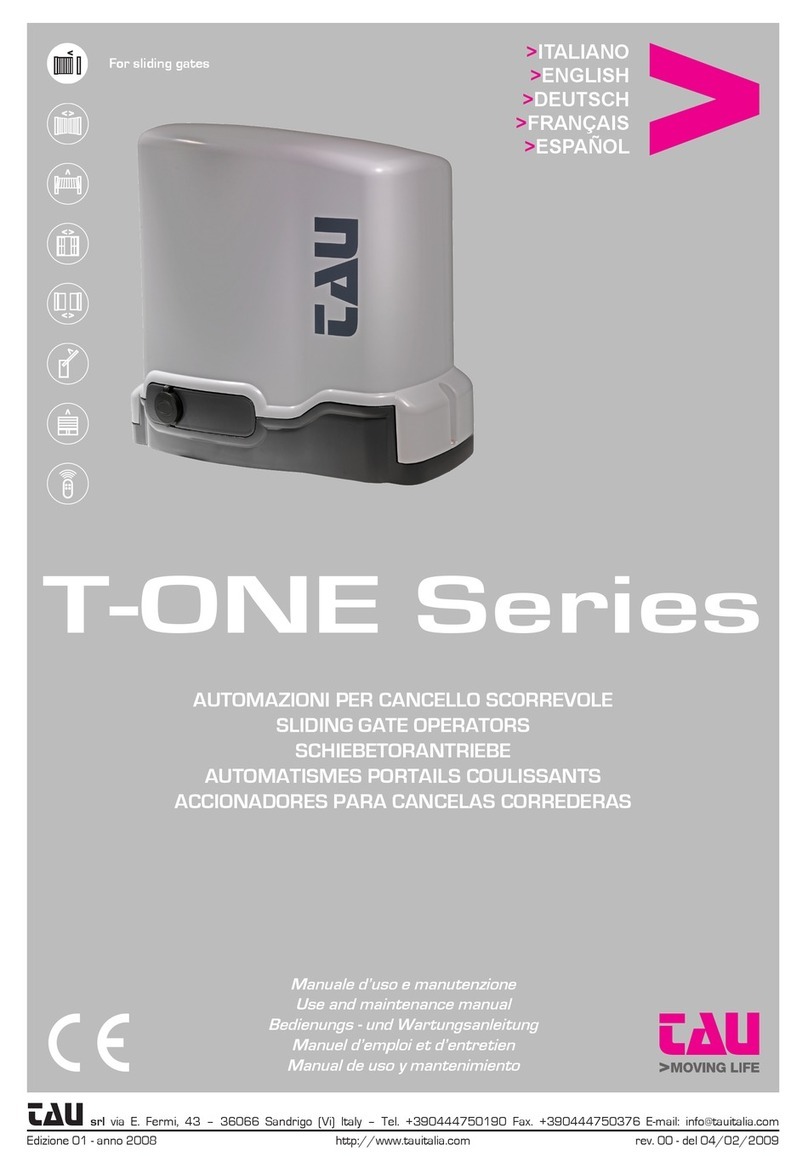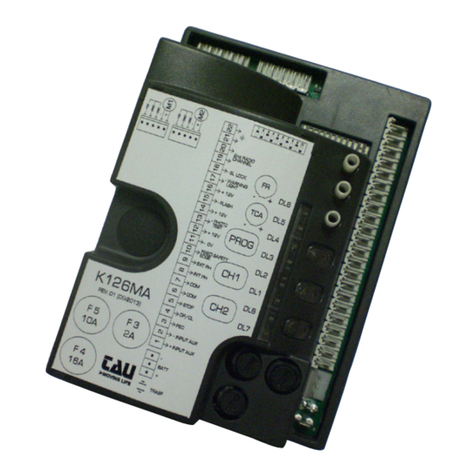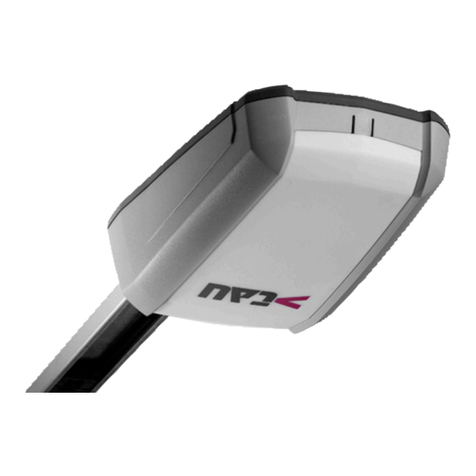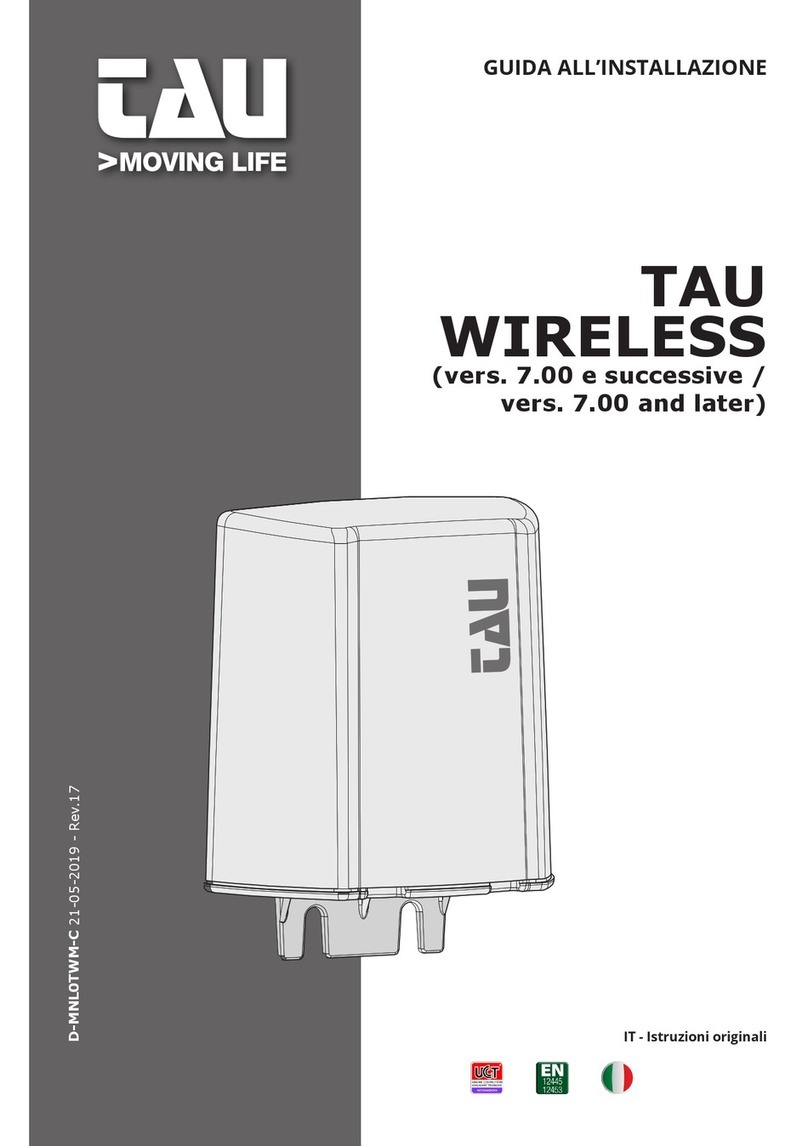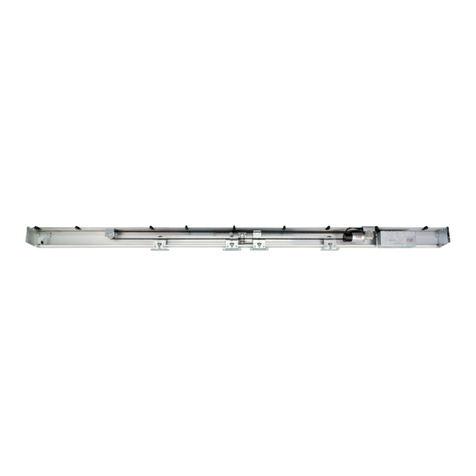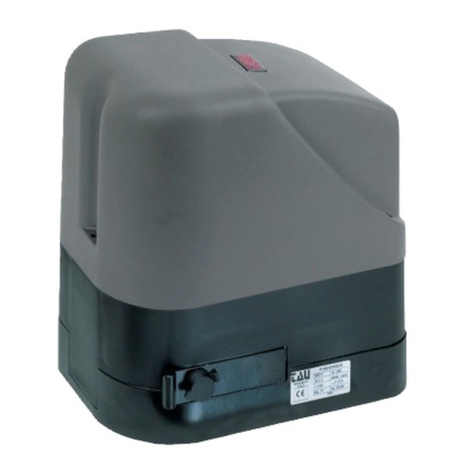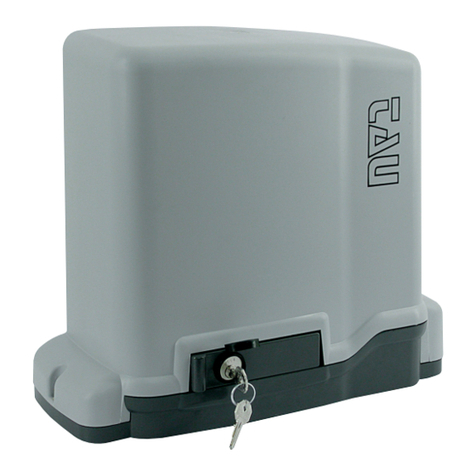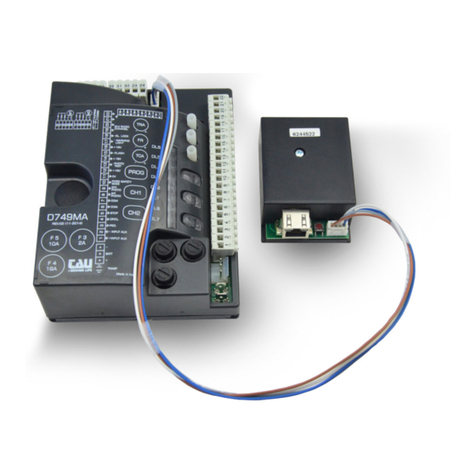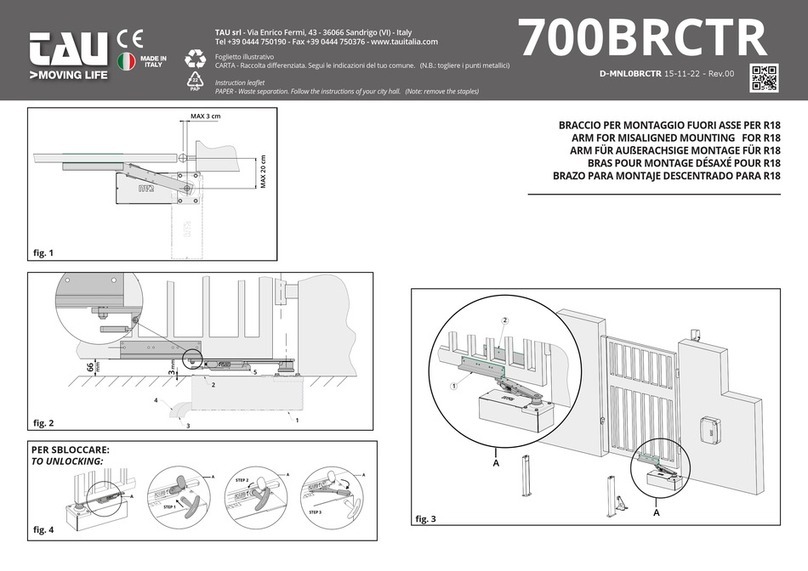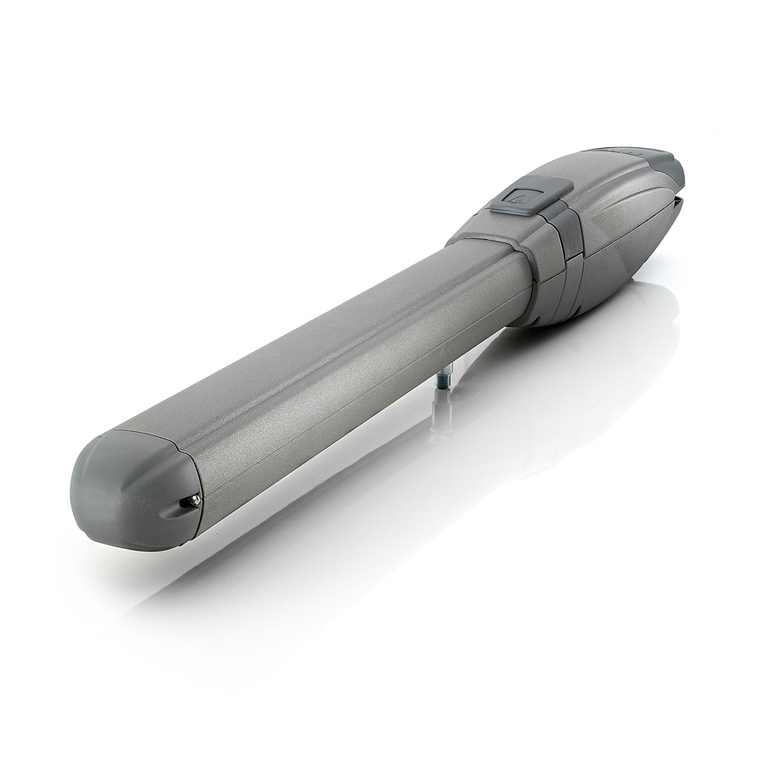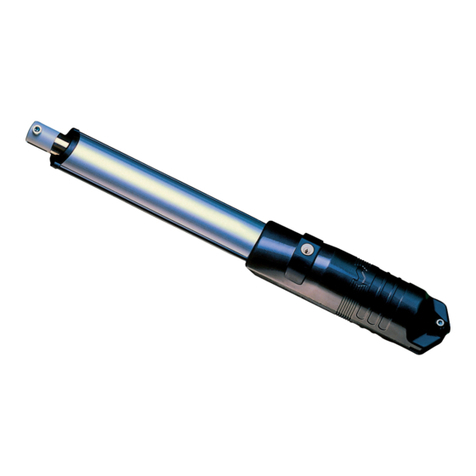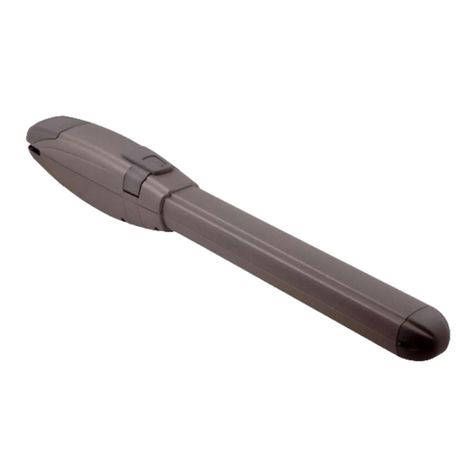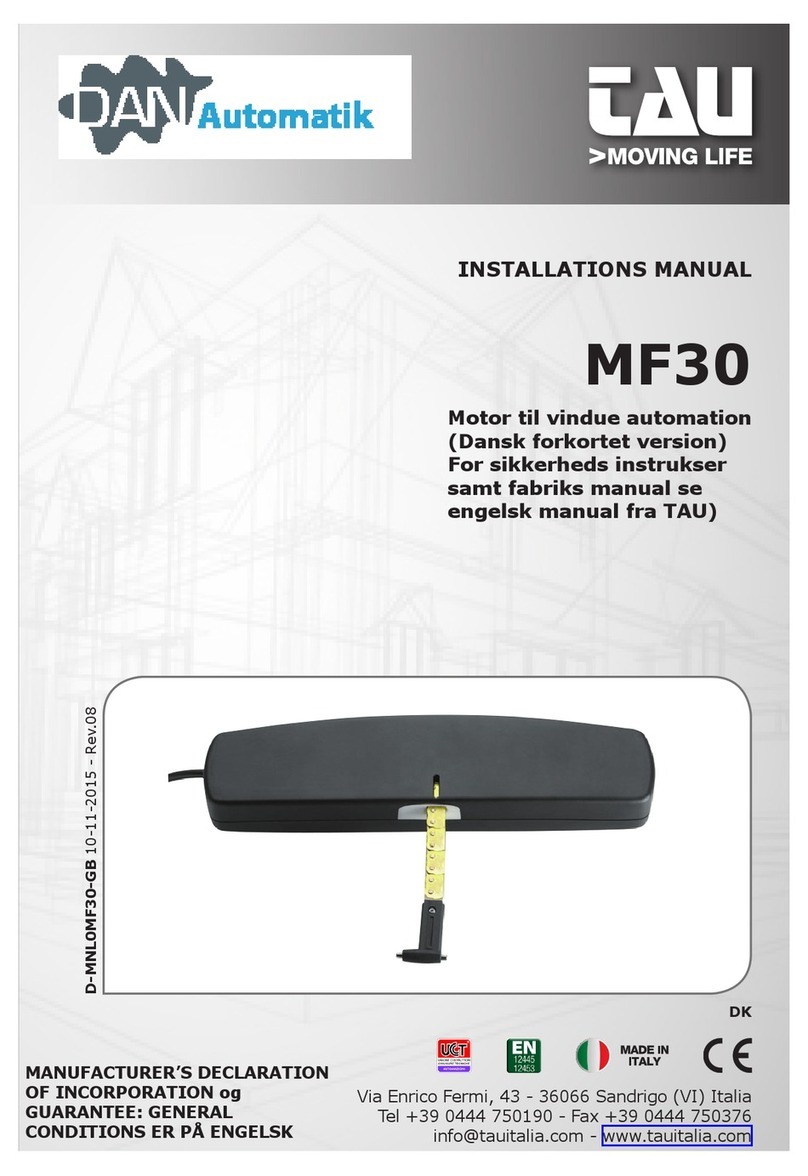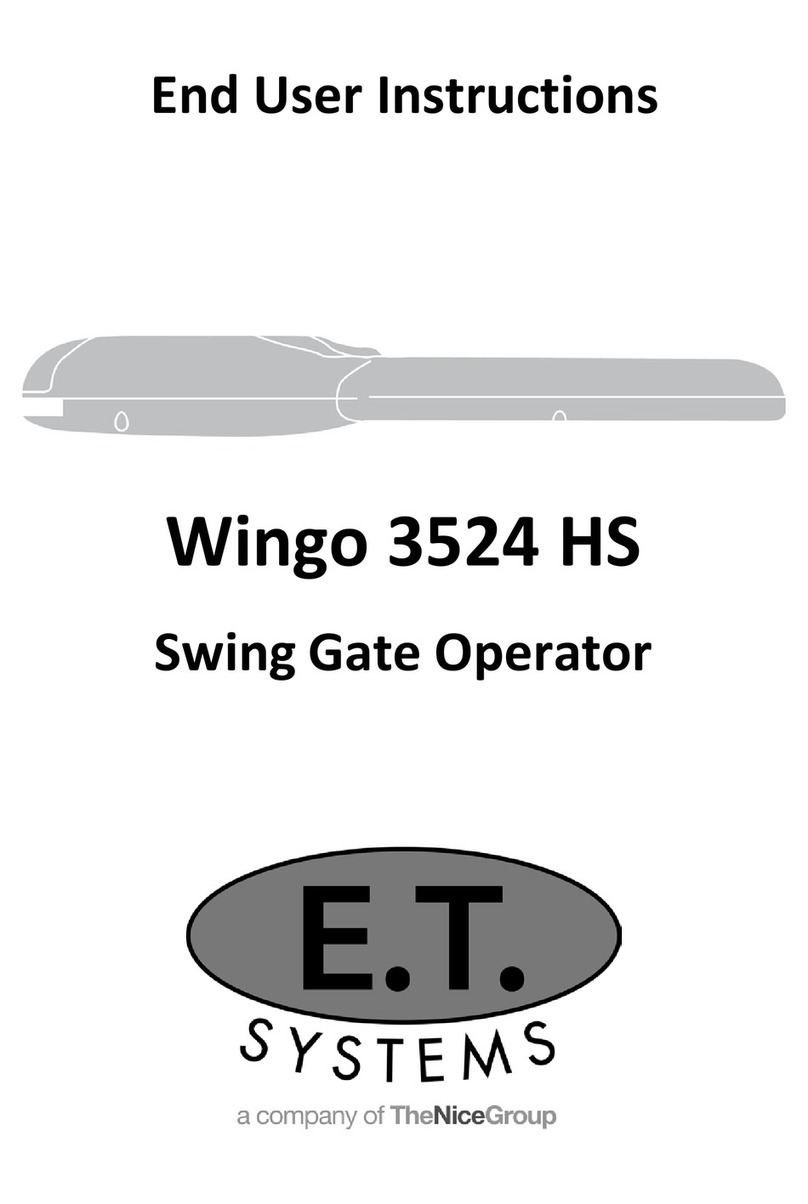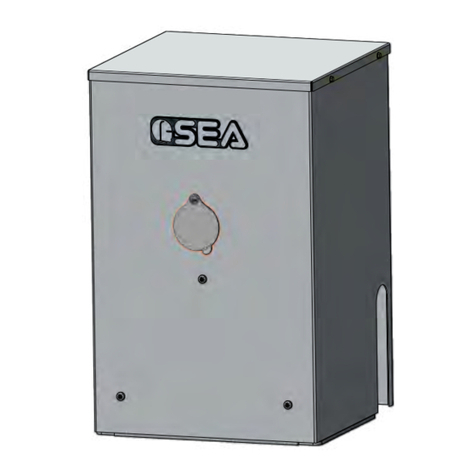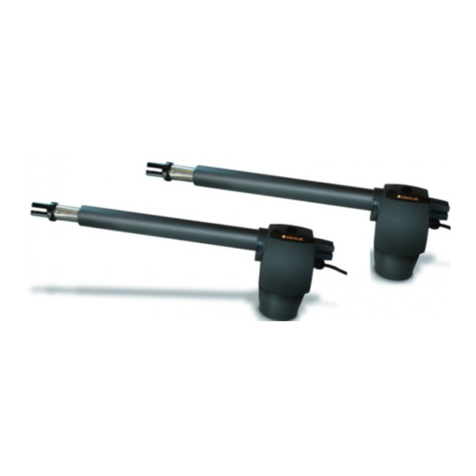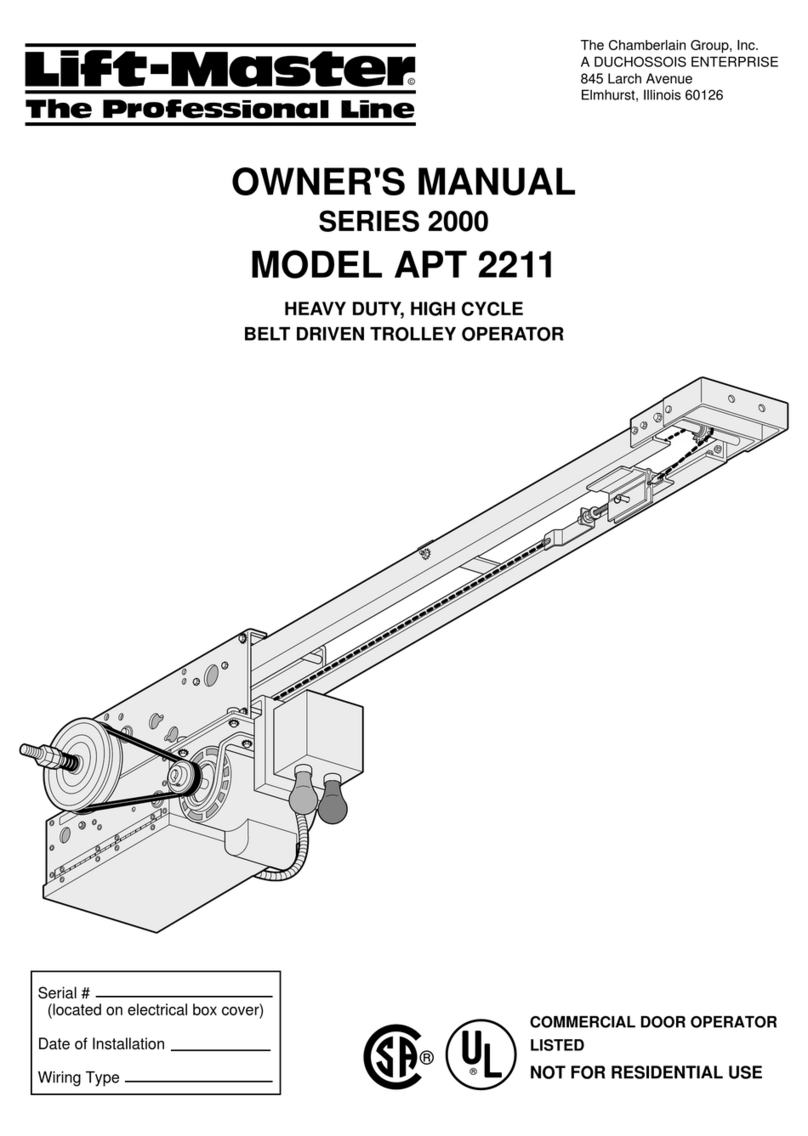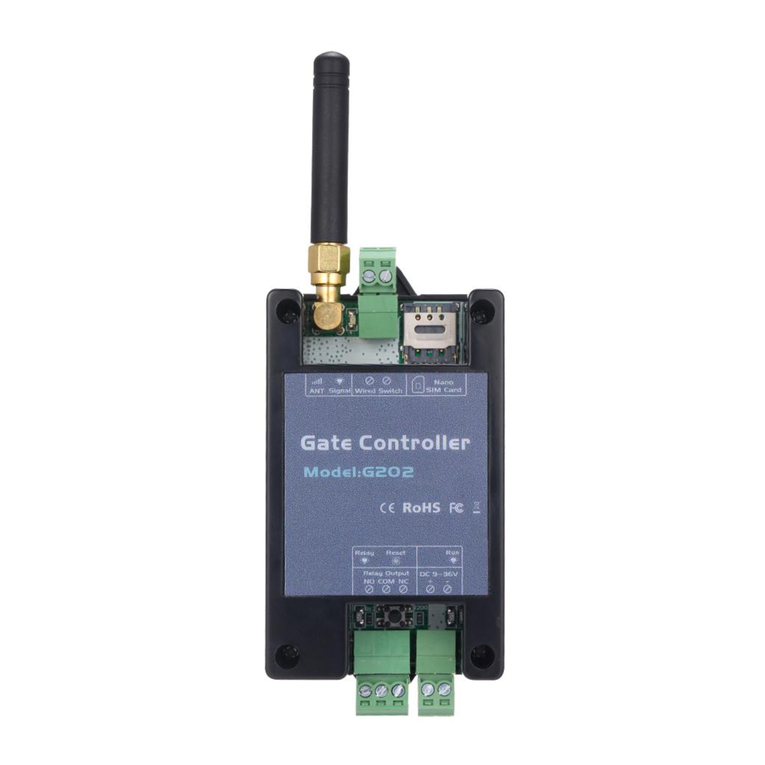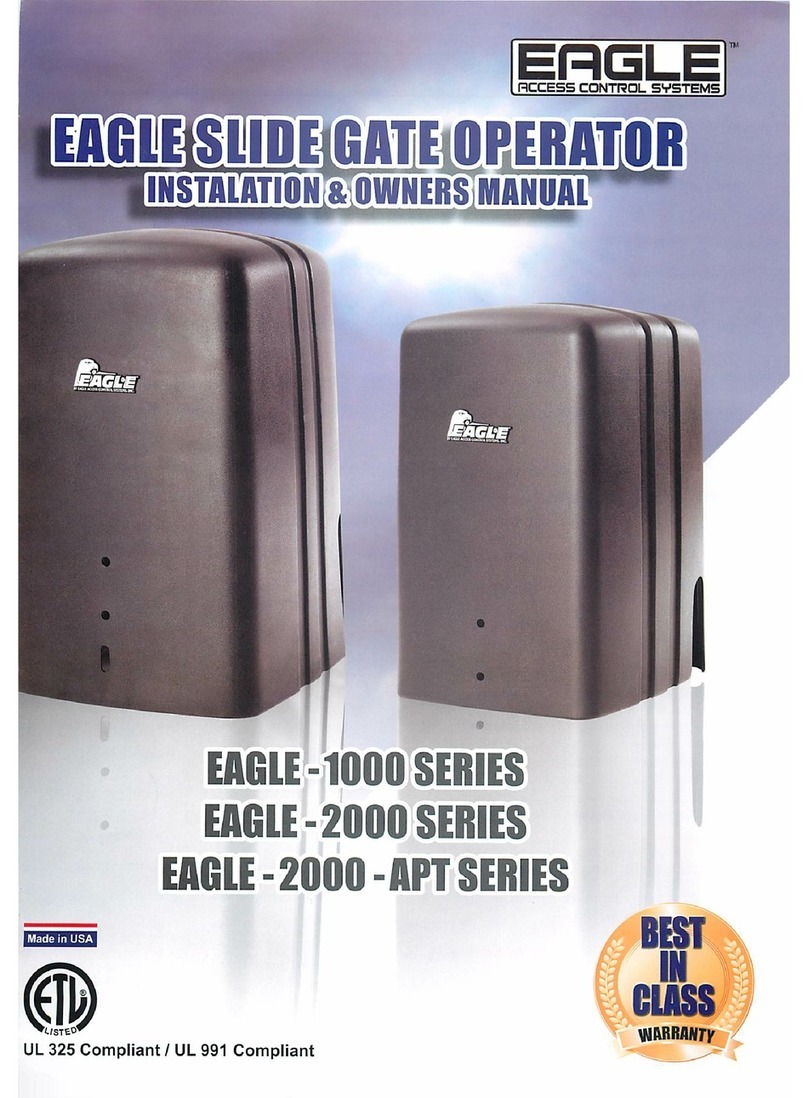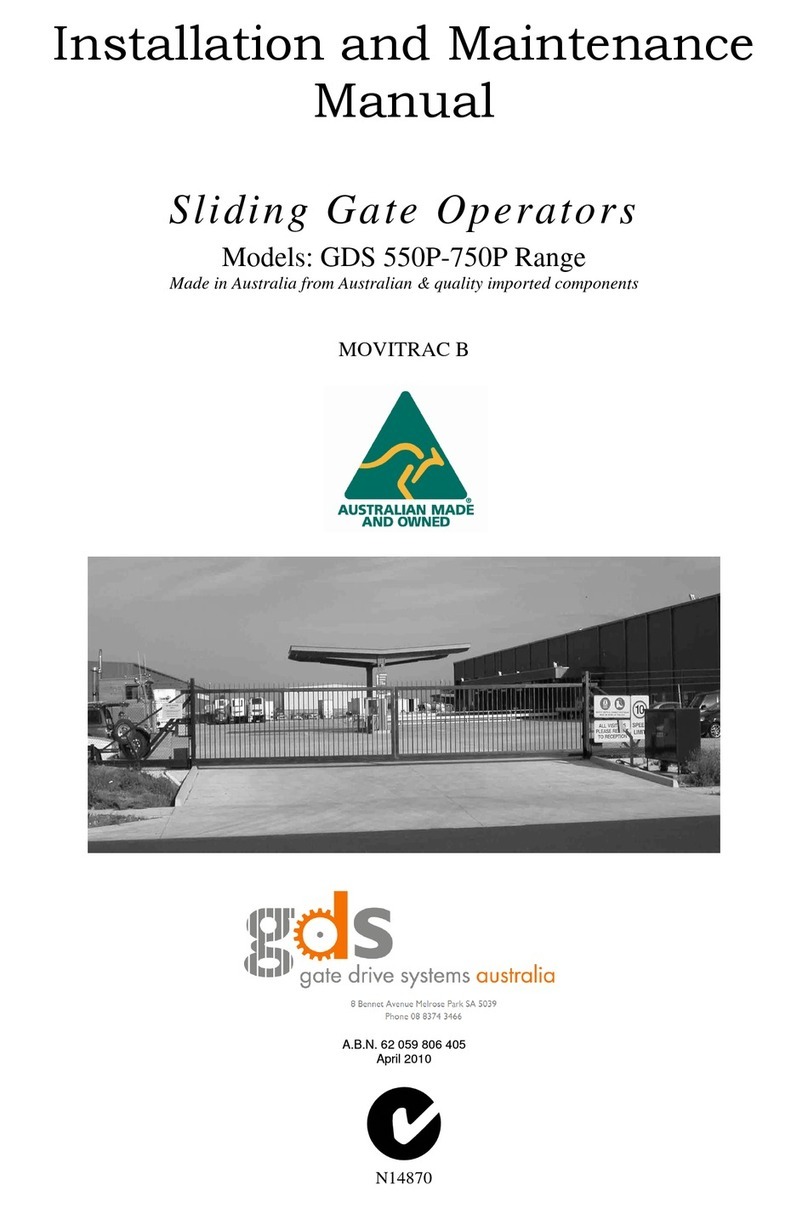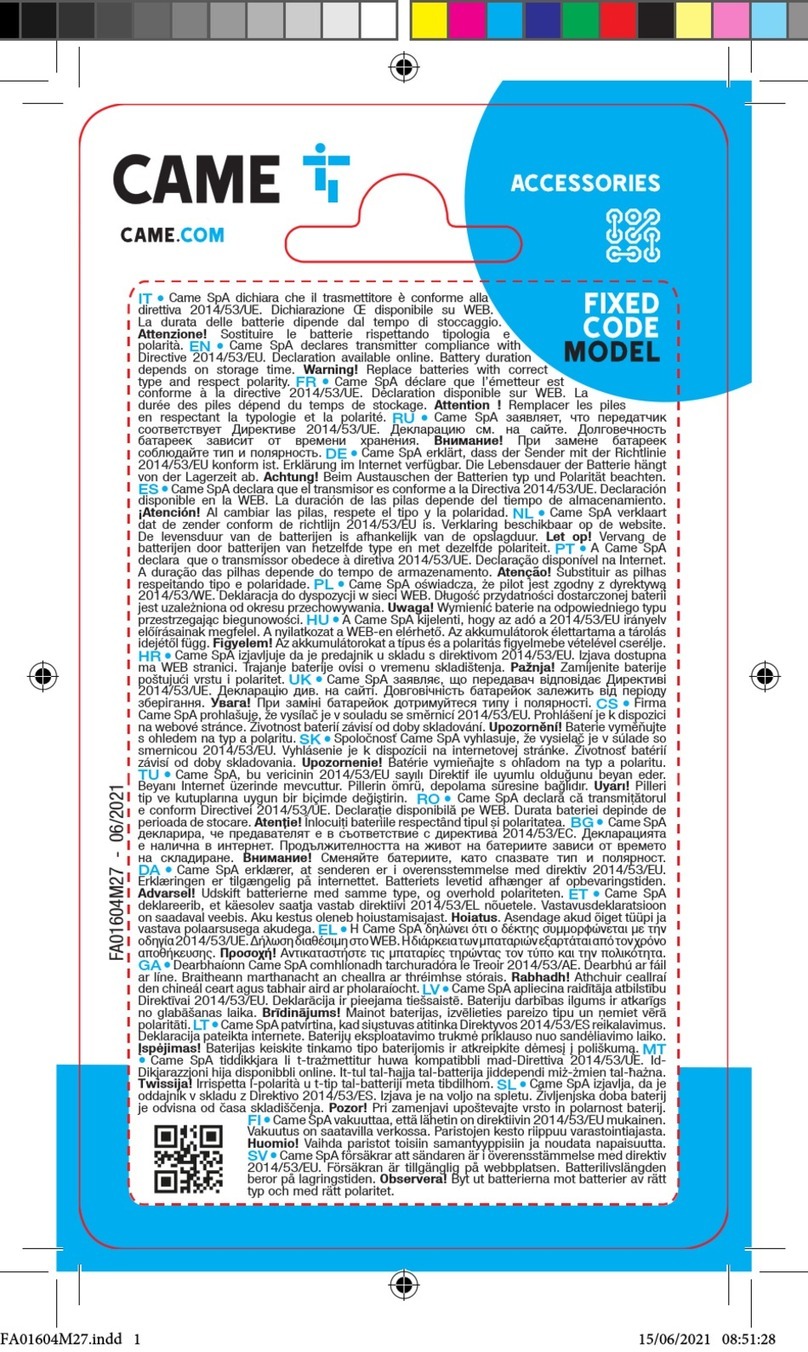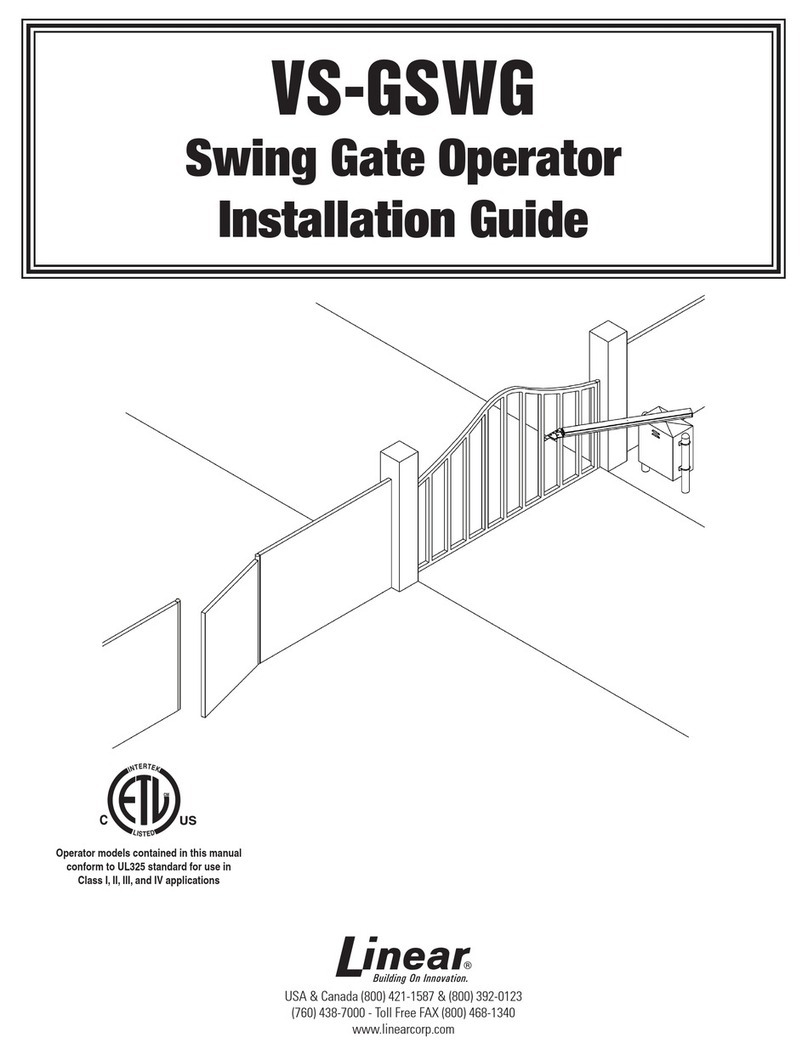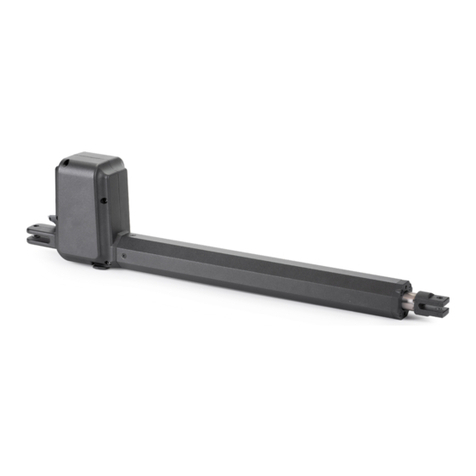tau R18 series User manual

1
R18 Series
MANUALE D’USO E MANUTENZIONE
USE AND MAINTENANCE MANUAL
BEDIENUNGS - UND WARTUNGSANLEITUNG
MANUEL D’EMPLOI ET D’ENTRETIEN
MANUAL DE USO Y MANTENIMIENTO
R18
Automatismo per Cancelli a Battente - Uso Residenziale/Condominiale
Swing Gate Operator - Residential/Communities
Drehtorantrieb für Privat und Gewerbe
Automatisme pour Portails à Battant – Usage Résidentiel/Intensif
Accionador para Puertas Batientes – Uso Residencial/Comunidades
Via Enrico Fermi, 43 - 36066 Sandrigo (VI) Italia
Tel +39 0444 750190 - Fax +39 0444 750376 - info@tauitalia.com - www.tauitalia.com
IT - Istruzioni originali
D_MNL0R18 17-11-2015 - Rev.22

2
R18 Series
I - La Casa costruttrice si riserva il diritto di apportare modiche o miglioramenti al prodotto senza alcun preavviso. Eventuali
imprecisioni o errori riscontrabili nel presente fascicolo, saranno corretti nella prossima edizione.
All’apertura dell’imballo vericare che il prodotto sia integro. Riciclare i materiali secondo la normativa vigente.
L’installazione del prodotto dovrà essere effettuata da personale qualicato. La Ditta costruttrice Tau declina ogni
responsabilità per danni derivanti a cose e/o persone dovuti ad un’eventuale errata installazione dell’impianto o la non
messa a Norma dello stesso secondo le vigenti Leggi (vedi Direttiva Macchine).
D - Der Hersteller behält sich das Recht vor, ohne vorherige Benachrichtung Änderungen oder Verbesserungen am Produkt
anzubringen. Ungenauigkeiten oder Fehler, die in der vorliegenden Ausgabe festgestellt werden, werden in der nächsten
Ausgabe berichtigt.
Beim Öffnen der Verpackung prüfen, dass das Produkt keine Schäden aufweist. Die Materialien nach den gültigen Vorschriften
recyclen.
Die Installation des Produktes muss von Fachpersonal ausgeführt werden. Die Herstellerrma TAU übernimmt keinerlei
Haftung für Personen- und/oder Sachschäden aufgrund einer falschen Installation der Anlage oder der Nichtkonformität
derselben mit den gültigen Gesetzen (siehe Maschinenrichtlinie).
GB - The manufacturer reserves the right to modify or improve products without prior notice. Any inaccuracies or errors found in this
handbook will be corrected in the next edition.
When opening the packing please check that the product is intact. Please recycle materials in compliance with current
regulations.
This product may only be installed by a qualied tter. The manufacturer declines all liability for damage to property
and/or personal injury deriving from the incorrect installation of the system or its non-compliance with current law (see
Machinery Directive).
F - Le Constructeur se réserve le droit d’apporter des modications ou des améliorations au produit sans aucun préavis. Les
éventuelles imprécisions ou erreurs présentes dans ce fascicule seront corrigées dans la prochaine édition.
À l’ouverture de l’emballage, vérier que le produit est intact. Recycler les matériaux suivant les normes en vigueur.
L’installation du produit devra être effectuée par du personnel qualié. Tau décline toute responsabilité pour les
dommages aux choses et/ou personnes dus à une éventuelle installation erronée de l’automatisme ou à la non-mise
aux normes suivant les lois en vigueur (voir Directive Machines).
E - El Fabricante se reserva el derecho de modicar o actualizar el producto sin aviso previo. Posibles imprecisiones o errores en
este manual serán corregidos en la próxima edición.
Cuando abra el embalaje, controle que el producto esté íntegro. Recicle los materiales según la normativa vigente.
La instalación del producto tiene que ser efectuada por personal cualicado. El Fabricante Tau no se asume ninguna
responsabilidad por lesiones a personas o averías a cosas causadas por una instalación incorrecta del equipo o la por
la inobservancia de la normativa vigente (véase Directiva de Máquinas).

3
R18 Series
AVVERTENZE PER L’INSTALLATORE
OBBLIGHI GENERALI PER LA SICUREZZA
A) Leggere attentamente le istruzioni prima di procedere all’installazione, in quanto forniscono importanti indicazioni concernenti la
sicurezza, l’installazione, l’uso e la manutenzione. Una errata installazione o un errato uso del prodotto può portare a gravi danni alle
persone.
B) I materiali dell’imballaggio (plastica, polistirolo, ecc.) non devono essere lasciati alla portata dei bambini in quanto potenziali fonti di pericolo.
C) Conservare le istruzioni per riferimenti futuri.
D) Questo prodotto è stato progettato e costruito esclusivamente per l’utilizzo indicato in questa documentazione. Qualsiasi altro utilizzo non
espressamente indicato potrebbe pregiudicare l’integrità del prodotto e/o rappresentare fonte di pericolo.
E) TAU declina qualsiasi responsabilità derivata dall’uso improprio o diverso da quello per cui l’automatismo è destinato.
F) Non installare il prodotto in ambiente e atmosfera esplosivi.
G) Gli elementi costruttivi meccanici devono essere in accordo con quanto stabilito dalle Norme EN 12604 e EN 12605. Per i Paesi extra-CEE, oltre
ai riferimenti normativi nazionali, per ottenere un livello di sicurezza adeguato, devono essere seguite le Norme sopra riportate.
H) TAU non è responsabile dell’inosservanza della Buona Tecnica nella costruzione delle chiusure da motorizzare, nonché delle deformazioni che
dovessero intervenire nell’utilizzo.
I) L’installazione deve essere effettuata nell’osservanza delle Norme EN 12453 e EN 12445. Il livello di sicurezza dell’automazione deve essere
C+D.
J) Prima di effettuare qualsiasi intervento sull’impianto, togliere l’alimentazione elettrica e scollegare le batterie.
K) Prevedere sulla rete di alimentazione dell’automazione un interruttore onnipolare con distanza d’apertura dei contatti uguale o superiore a 3 mm.
È consigliabile l’uso di un magnetotermico da 6A con interruzione onnipolare.
L) Vericare che a monte dell’impianto vi sia un interruttore differenziale con soglia da 0,03 A.
M) Vericare che l’impianto di terra sia realizzato a regola d’arte e collegarvi le parti metalliche della chiusura.
N) L’automazione dispone di una sicurezza intrinseca antischiacciamento costituita da un controllo di coppia. E’ comunque necessario vericarne
la soglia di intervento secondo quanto previsto dalle Norme indicate al punto I.
O) I dispositivi di sicurezza (norma EN 12978) permettono di proteggere eventuali aree di pericolo da Rischi meccanici di movimento, come ad Es.
schiacciamento, convogliamento, cesoiamento.
P) Per ogni impianto è consigliato l’utilizzo di almeno una segnalazione luminosa nonché di un cartello di segnalazione ssato adeguatamente sulla
struttura dell’insso, oltre ai dispositivi citati al punto O.
Q) Il costruttore dell’automazione declina ogni responsabilità qualora vengano installati componenti incompatibili ai ni della sicurezza e del buon
funzionamento. Per l’eventuale riparazione o sostituzione dei prodotti dovranno essere utilizzati esclusivamente ricambi originali.
R) Per la manutenzione utilizzare esclusivamente parti originali TAU.
S) Non eseguire alcuna modica sui componenti facenti parte del sistema d’automazione.
T) L’installatore deve fornire tutte le informazioni relative al funzionamento manuale del sistema in caso di emergenza e consegnare all’Utente
utilizzatore dell’impianto la “Guida Utente” allegata al prodotto.
U) Non permettere ai bambini o persone di sostare nelle vicinanze del prodotto durante il funzionamento.
W) Tenere fuori dalla portata dei bambini radiocomandi o qualsiasi altro datore di impulso, per evitare che l’automazione possa essere azionata
involontariamente.
X) Il transito tra le ante deve avvenire solo a cancello completamente aperto.
Y) L’Utente utilizzatore deve astenersi da qualsiasi tentativo di riparazione o d’intervento diretto e rivolgersi solo a personale qualicato.
Z) Tutto quello che non è previsto espressamente in queste istruzioni non è permesso.
Consigliamo di riporre tutta la documentazione relativa all’impianto all’interno o nelle immediate vicinanze della centralina.
Italiano
IMPORTANT NOTICE FOR THE INSTALLER
GENERAL SAFETY REGULATIONS
A) Please read these instructions carefully before installing the product as they contain important information concerning safety, instal-
lation, use and maintenance. Incorrect installation or incorrect use of the product could cause serious harm to people.
B) Do not leave packing materials (plastic, polystyrene, etc.) within reach of children as such materials are potential sources of danger.
C) Store these instructions for future reference.
D) This product was designed and built strictly for the use indicated in this documentation. Any other use, not expressly indicated here, could com-
promise the good condition/operation of the product and/or be a source of danger.
E) TAU declines all liability caused by improper use or use other than that for which the automated system was intended.
F) Do not install the product in explosive environments.
G) The mechanical parts must conform to the provisions of Standards EN 12604 and EN 12605. For non-EU countries, to obtain an adequate level
of safety, the Standards mentioned above must be observed, in addition to national legal regulations.
H) TAU is not responsible for failure to observe Good Technique in the construction of the closing elements to be motorised, or for any deformation
that may occur during use.
I) The installation must conform to Standards EN 12453 and EN 12445. The safety level of the automated system must be C+D.
J) Before attempting any job on the system, cut out electrical power and disconnect the batteries.
K) The mains power supply of the automated system must be tted with an all-pole switch with contact opening distance of 3mm or greater. Use of
a 6A thermal breaker with all-pole circuit break is recommended.
L) Make sure that a differential switch with threshold of 0.03 A is tted upstream of the system.
M) Make sure that the earthing system is perfectly constructed, and connect metal parts of the means of the closure to it.
N) The automated system is supplied with an intrinsic anti-crushing safety device consisting of a torque control. Nevertheless, its tripping threshold
must be checked as specied in the Standards indicated at point “I”.
O) The safety devices (EN 12978 standard) protect any danger areas against mechanical movement Risks, such as crushing, dragging, and shear-
ing.
P) Use of at least one indicator-light is recommended for every system, as well as a warning sign adequately secured to the frame structure, in
addition to the devices mentioned at point “O”.
Q) The manufacturer declines all liability if incompatible safety and components are installed. Only use original spare parts to repair or replace the
product.
R) For maintenance, strictly use original parts by TAU.
S) Do not in any way modify the components of the automated system.
T) The installer shall supply all information concerning manual operation of the system in case of an emergency, and shall hand over to the user
the “User Guide” supplied with the product.
U) Do not allow children or adults to stay near the product while it is operating.
W) Keep remote controls or other pulse generators away from children, to prevent the automated system from being activated involuntarily.
X) Transit through the leaves is allowed only when the gate is fully open.
Y) The user must not attempt any kind of repair or direct action whatever and contact qualied personnel only.
Z) Anything not expressly specied in these instructions is not permitted.
Keep all the documents concerning the system inside or near the central control unit.
English

4
R18 Series
CONSIGNES POUR L’INSTALLATEUR
RÈGLES DE SÉCURITÉ
A) Lire attentivement les instructions avant de procéder à l’installation, dans la mesure où elles fournissent des indications importantes concernant la
sécurité, l’installation, l’emploi et la maintenance. Une installation erronée ou un usage erroné du produit peut entraîner de graves conséquences
pour les personnes.
B) Les matériaux d’emballage (matière plastique, polystyrène, etc.) ne doivent pas être laissés à la portée des enfants car ils constituent des sources potentielles
de danger.
C) Conserver les instructions pour les références futures.
D) Ce produit a été conçu et construit exclusivement pour l’usage indiqué dans cette documentation. Toute autre utilisation non expressément indiquée pourrait
compromettre l’intégrité du produit et/ou représenter une source de danger.
E) TAU décline toute responsabilité qui dériverait d’usage impropre ou différent de celui auquel l’automatisme est destiné.
F) Ne pas installer le produit dans un environnement et une atmosphère explosifs.
G) Les composants mécaniques doivent répondre aux prescriptions des Normes EN 12604 et EN 12605. Pour les Pays extra-CEE, l’obtention d’un niveau de
sécurité approprié exige non seulement le respect des normes nationales, mais également le respect des Normes susmentionnées.
H) TAU n’est pas responsable du non-respect de la Bonne Technique dans la construction des fermetures à motoriser, ni des déformations qui pourraient intervenir
lors de l’utilisation.
I) L’installation doit être effectuée conformément aux Normes EN 12453 et EN 12445. Le niveau de sécurité de l’automatisme doit être C+D.
J) Couper l’alimentation électrique et déconnecter la batterie avant toute intervention sur l’installation.
K) Prévoir, sur le secteur d’alimentation de l’automatisme, un interrupteur omnipolaire avec une distance d’ouverture des contacts égale ou supérieure à 3 mm. On
recommande d’utiliser un magnétothermique de 6A avec interruption omnipolaire.
L) Vérier qu’il y ait, en amont de l’installation, un interrupteur différentiel avec un seuil de 0,03 A.
M) Vérier que la mise à terre est réalisée selon les règles de l’art et y connecter les pièces métalliques de la fermeture.
N) L’automatisme dispose d’une sécurité intrinsèque anti-écrasement, formée d’un contrôle du couple. Il est toutefois nécessaire d’en vérier le seuil d’intervention
suivant les prescriptions des Normes indiquées au point “I”.
O) Les dispositifs de sécurité (norme EN 12978) permettent de protéger des zones éventuellement dangereuses contre les Risques mécaniques du mouvement,
comme l’écrasement, l’acheminement, le cisaillement.
P) On recommande que toute installation soit doté au moins d’une signalisation lumineuse, d’un panneau de signalisation xé, de manière appropriée, sur la struc-
ture de la fermeture, ainsi que des dispositifs cités au point “O”.
Q) Le constructeur de l’automatisme décline toute responsabilité en cas d’installation de composants incompatibles en matière de sécurité et de bon fonctionne-
ment. Pour toute réparation ou pour tout remplacement des produits, il faudra utiliser exclusivement des pièces de rechange originales.
R) Utiliser exclusivement, pour l’entretien, des pièces TAU originales.
S) Ne jamais modier les composants faisant partie du système d’automatisme.
T) L’installateur doit fournir toutes les informations relatives au fonctionnement manuel du système en cas d’urgence et remettre à l’Usager qui utilise l’installation
le “Guide Usager” fournie avec le produit.
U) Interdire aux enfants ou aux tiers de stationner près du produit durant le fonctionnement.
W) Eloigner de la portée des enfants les radiocommandes ou tout autre générateur d’impulsions, pour éviter tout actionnement involontaire de l’automatisme.
X) Le transit entre les vantaux ne doit avoir lieu que lorsque le portail est complètement ouvert.
Y) L’Usager qui utilise l’installation doit éviter toute tentative de réparation ou d’intervention directe et s’adresser uniquement à un personnel qualié.
Z) Tout ce qui n’est pas prévu expressément dans ces instructions est interdit.
Nous conseillons de conserver toute la documentation relative à l’installation à l’intérieur de l’armoire de commande ou à proximité immédiate.
HINWEISE FÜR DEN INSTALLATIONSTECHNIKER
ALLGEMEINE SICHERHEITSVORSCHRIFTEN
A) Die Anweisungen vor der Installation genau lesen, da sie wichtige Hinweise mit Bezug auf Sicherheit, Installation, Bedienung und Wartung liefern.
Eine falsche Installation oder ein fehlerhafter Betrieb des Produktes können zu schwerwiegenden Personenschäden führen.
B) Das Verpackungsmaterial (Kunststoff, Styropor, usw.) sollte nicht in Reichweite von Kindern aufbewahrt werden, da es eine potentielle Gefahrenquelle darstellt.
C) Die Anleitung sollte aufbewahrt werden, um auch in Zukunft Bezug auf sie nehmen zu können.
D) Dieses Produkt wurde ausschließlich für den in diesen Unterlagen angegebenen Gebrauch entwickelt und hergestellt. Jeder andere Gebrauch, der nicht aus-
drücklich angegeben ist, könnte die Unversehrtheit des Produktes beeinträchtigen und/oder eine Gefahrenquelle darstellen.
E) Die Firma TAU lehnt jede Haftung für Schäden, die durch unsachgemäßen oder nicht bestimmungsgemäßen Gebrauch der Automatik verursacht werden, ab.
F) Das Produkt nicht in EX-Umgebung bzw. EX-Atmosphäre installieren.
G) Die mechanischen Bauelemente müssen den Anforderungen der Normen EN 12604 und EN 12605 entsprechen. Für Länder, die nicht der Europäischen Union
angehören, sind für die Gewährleistung eines entsprechenden Sicherheitsniveaus neben den nationalen gesetzlichen Bezugsvorschriften die oben aufgeführten
Normen zu beachten.
H) Die Firma TAU übernimmt keine Haftung im Falle von nicht fachgerechten Ausführungen bei der Herstellung der anzutreibenden Schließvorrichtungen sowie bei
Deformationen, die eventuell beim Betrieb entstehen.
I) Die Installation muß unter Beachtung der Normen EN 12453 und EN 12445 erfolgen. Die Sicherheitsstufe der Automatik sollte C+D sein.
J) Vor der Ausführung jeglicher Eingriffe auf der Anlage sind die elektrische Versorgung und die Batterie abzunehmen.
K) Auf dem Versorgungsnetz der Automatik ist ein omnipolarer Schalter mit Öffnungsabstand der Kontakte von über oder gleich 3 mm einzubauen. Darüber hinaus
wird der Einsatz eines Magnetschutzschalters mit 6A mit omnipolarer Abschaltung empfohlen.
L) Es sollte überprüft werden, ob vor der Anlage ein Differentialschalter mit einer Auslöseschwelle von 0,03 A zwischengeschaltet ist.
M)
Es sollte überprüft werden, ob die Erdungsanlage fachgerecht ausgeführt wurde. Die Metallteile der Schließung sollten an diese Anlage angeschlossen werden.
N) Die Automation verfügt über eine eingebaute Sicherheitsvorrichtung für den Quetschschutz, die aus einer Drehmomentkontrolle besteht. Es ist in jedem Falle
erforderlich, deren Eingriffsschwelle gemäß der Vorgaben der unter Punkt “I” angegebenen Vorschriften zu überprüfen.
O) Die Sicherheitsvorrichtungen (Norm EN 12978) ermöglichen den Schutz eventueller Gefahrenbereiche vor mechanischen Bewegungsrisiken, wie zum Beispiel
Quetschungen, Mitschleifen oder Schnittverletzungen.
P) Für jede Anlage wird der Einsatz von mindestens einem Leuchtsignal empfohlen sowie eines Hinweisschildes, das über eine entsprechende Befestigung mit
dem Aufbau des Tors verbunden wird. Darüber hinaus sind die unter Punkt ”O” erwähnten Vorrichtungen einzusetzen.
Q) Der Hersteller der Automatisierung übernimmt keinerlei Haftung, falls Bestandteile installiert werden, die – was Sicherheit und korrekten Betrieb betrifft – nicht
kompatibel sind. Zur Reparatur oder zum Ersatz der Produkte dürfen ausschließlich Originalersatzteile verwendet werden.
R) Bei der Instandhaltung sollten ausschließlich Originalteile der Firma TAU verwendet werden.
S) Auf den Komponenten, die Teil des Automationssystems sind, sollten keine Veränderungen vorgenommen werden.
T) Der Installateur sollte alle Informationen hinsichtlich des manuellen Betriebs des Systems in Notfällen liefern und dem Betreiber der Anlage das “Führer Benut-
zer”, das dem Produkt beigelegt ist, übergeben.
U) Weder Kinder noch Erwachsene sollten sich während des Betriebs in der unmittelbaren Nähe der Automation aufhalten.
W) Die Funksteuerungen und alle anderen Impulsgeber sollten außerhalb der Reichweite von Kindern aufbewahrt werden, um ein versehentliches Aktivieren der
Automation zu vermeiden.
X) Der Durchgang oder die Durchfahrt zwischen den Flügeln darf lediglich bei vollständig geöffnetem Tor erfolgen.
Y)
Der Betreiber sollte keinerlei Reparaturen oder direkte Eingriffe auf der Automation ausführen, sondern sich hierfür ausschließlich an qualiziertes Fachpersonal wenden.
Z) Alle Vorgehensweisen, die nicht ausdrücklich in der vorliegenden Anleitung vorgesehen sind, sind nicht zulässig
Wir empfehlen, alle Unterlagen der Anlage in der Steuerzentrale oder in ihrer unmittelbaren Nähe aufzubewahren.
Deutsch
Français

5
R18 Series
INDICE - INHALTSVERZEICHNIS - CONTENTS - INDEX – ÍNDICE
pag. 6 Caratteristiche tecniche della serie R18 - Technische Eigenschaften der serie R18 - Technical features of the R18 series
- Caractéristiques techinques de la série R18 - Características técnicas de la serie R18.
pag. 7 Italiano
pag. 10 English
pag. 13 Disegni - Drawings - Zeichnen - Projets - Dibujos
pag. 17 Deutsch
pag. 20 Français
pag. 23 Español
pag. 27 Garanzia - Garantie - Guarantee - Garantie - Garantía
ADVERTENCIAS PARA EL INSTALADOR
REGLAS GENERALES PARA LA SEGURIDAD
A) Lea con atención las instrucciones antes de proceder con la instalación, puesto que suministran importantes indicaciones sobre la
seguridad, instalación, uso y mantenimiento. Una instalación incorrecta o un uso impropio del producto puede causar graves daños
a las personas.
B) Los materiales del embalaje (plástico, poliestireno, etc.) no deben dejarse al alcance de los niños, ya que constituyen fuentes potenciales de
peligro.
C) Guarden las instrucciones para futuras consultas.
D) Este producto ha sido proyectado y fabricado exclusivamente para la utilización indicada en el presente manual. Cualquier uso diverso del
previsto podría perjudicar el funcionamiento del producto y/o representar fuente de peligro.
E) TAU declina cualquier responsabilidad derivada de un uso impropio o diverso del previsto.
F) No instale el producto en locales con atmósfera explosiva.
G) Los elementos constructivos mecánicos deben estar de acuerdo con lo establecido en las Normas EN 12604 y EN 12605. Para los países no
pertenecientes a la CEE, además de las referencias normativas nacionales, para obtener un nivel de seguridad adecuado, deben seguirse las
Normas arriba indicadas.
H) TAU no es responsable del incumplimiento de las buenas técnicas de fabricación de los cierres que se han de motorizar, así como de las defor-
maciones que pudieran intervenir en la utilización.
I)
La instalación debe ser realizada de conformidad con las Normas EN 12453 y EN 12445. El nivel de seguridad de la automación debe ser C+D.
J) Quiten la alimentación eléctrica y desconecten las baterías antes de efectuar cualquier intervención en la instalación.
K) Coloquen en la red de alimentación de la automación un interruptor omnipolar con distancia de apertura de los contactos igual o superior a 3
mm. Se aconseja usar un magnetotérmico de 6A con interrupción omnipolar.
L) Comprueben que la instalación disponga línea arriba de un interruptor diferencial con umbral de 0,03 A.
M) Veriquen que la instalación de tierra esté correctamente realizada y conecten las partes metálicas del cierre.
N) La automación dispone de un dispositivo de seguridad antiaplastamiento constituido por un control de par. No obstante, es necesario comprobar
el umbral de intervención según lo previsto en las Normas indicadas en el punto “I”.
O) Los dispositivos de seguridad (norma EN 12978) permiten proteger posibles áreas de peligro de Riesgos mecánicos de movimiento, como por
ej. aplastamiento, arrastre, corte.
P) Para cada equipo se aconseja usar por lo menos una señalización luminosa así como un cartel de señalización adecuadamente jado a la
estructura del bastidor, además de los dispositivos indicados en el “O”.
Q) El fabricante de la automatización no se asume ninguna responsabilidad si se instalan componentes incompatibles para la seguridad y el fun-
cionamiento correcto. Para una posible reparación o sustitución de los productos, use sólo recambios originales.
R) Para el mantenimiento utilicen exclusivamente piezas originales TAU.
S) No efectúen ninguna modicación en los componentes que forman parte del sistema de automación.
T) El instalador debe proporcionar todas las informaciones relativas al funcionamiento del sistema en caso de emergencia y entregar al usuario del
equipo la “Guía Usuario” que se adjunta al producto.
U) No permitan que niños o personas se detengan en proximidad del producto durante su funcionamiento.
W) Mantengan lejos del alcance los niños los telemandos o cualquier otro emisor de impulso, para evitar que la automación pueda ser accionada
involuntariamente.
X) Sólo puede transitarse entre las hojas si la cancela está completamente abierta.
Y) El usuario no debe por ningún motivo intentar reparar o modicar el producto, debe siempre dirigirse a personal cualicado.
Z) Todo lo que no esté previsto expresamente en las presentes instrucciones debe entenderse como no permitido.
Se aconseja guardar toda la documentación de la instalación en el interior o cerca de la central.
Español

6
R18 Series
CARATTERISTICHE TECNICHE DELLA SERIE R18
TECHNICAL FEATURES OF THE R18 SERIES
TECHNISCHE EIGENSCHAFTEN DER SERIE R18
CARACTÉRISTIQUES TECHNIQUES DE LA SÉRIE R18
CARACTERÍSTICAS TÉCNICAS DE LA SERIE R18
R18 R18 BENC/L R18 BENCVEL
Alimentazione \ Power input \ Stromversorgung \ Alimentation \ Alimentación 230 V AC 50/60 Hz
Alimentazione Motore \ Power input to motor \ Motorversorgung \
Alimentation Moteur \ Alimentación motor 230 V AC 18 V DC
Corrente assorbita a vuoto \ Absorbed current (no load) \ Aufgenommene
Strom (leer) \ Courant absorbé (à vide) \ Corriente absorbida (en vacío) 1,3 A 0,7 A 0,8 A
Potenza assorbita a vuoto \ Absorbed power (no load) \ Aufgenommene
Leistung (leer) \ Puissance absorbée (à vide) \ Potencia absorbida (en vacío) 240 W 120 W 120 W
Intervento di termoprotezione \ Thermal protection trips at \ Ansprechen des
Wärmeschutzes \ Intervention protection thermique \ Desconexión protección
térmica
160 °C
(autoreset) -
Coppia max. \ Max. torque \ Max. Drehmoment \ Couple max. \ Par máx. 148 Nm 192 Nm 180 Nm
Rapporto di riduzione \ Reduction ratio \ Untersetzungsverhältnis \ Rapport
de réduction \ Relación de reducción 1/1485
Lunghezza consigliata anta* \ Recommended length of leaf* \ Empfohlene
Torügellänge* \ Longueur conseillée battant* \ Longitud recomendada hoja* 1,8 mt. 1,2 mt.
Corsa utile \ Useful travel \ Arbeitshub \ Course utile \ Carrera útil 360°
Tempo corsa 90° (a vuoto) \ 90° travel time (no load) \ Laufzeit, 90° (ohne
Last) \ Temps de course 90° (à vide) \ Tiempo recorrido 90°(en vacío)
21” 13” 9”
Temperatura di esercizio \ Operating temperature \ Betriebstemperatur \
Température de fonctionnement \ Temperatura de servicio Da –20 °C a +55 °C
Peso \ Weight \ Gewicht \ Poids \ Peso 8 Kg 7,2 Kg 7,2 Kg
IP Motore \ Motor IP \ Schutzart des Motor (IP) \ IP Moteur \ IP Motor IP 67
Ciclo di lavoro \ Work cycle \ Arbeitzzyklus \ Cycle de travail \ Ciclo de trabajo 32% 100%
* L’anta può essere più lunga di 1,8 m ma non deve superare il peso di 200 Kg. Per lunghezze superiori a 1,8 m, non è garantito
il funzionamento.
* Der Flügel kann länger als 1,8 m sein, er darf aber nicht mehr als 200 kg wiegen. Im Falle von Längen über 1,8 m wird der Betrieb
nicht garantiert.
* The leaf may be wider than 1.8 m but must not weigh over 200 Kg. Correct operation is not guaranteed for leaf widths greater
than 1.8 m.
* Le battant peut mesurer plus d’1,8 m de long mais il ne doit pas dépasser 200 Kg. Pour les longueurs supérieures à 1,8 m, le
fonctionnement n’est pas garanti.
* La hoja puede tener una longitud superior a los 1,8 m pero no puede superar los 200 Kg de peso. Para longitudes superiores a
los 1,8 m, no se garantiza el funcionamiento.
NOTA: QUANDO IL SISTEMA IN 12 VDC È ALIMENTATO UNICAMENTE DALLA BATTERIA (IN CASO DI BLACK-OUT OPPURE
IN ABBINAMENTO CON PANNELLO FOTOVOLTAICO), LE PRESTAZIONI ESPRESSE DAL MOTORIDUTTORE (FORZA E
VELOCITÀ) SI RIDUCONO DEL 30% CA.
N.B. WHEN THE SYSTEM IS IN THE 12 V DC MODE AND IS POWERED BY THE BATTERY ONLY (IN THE EVENT OF A POWER
FAILURE OR WHEN USED IN CONJUNCTION WITH A PHOTOVOLTAIC PANEL), THE GEAR MOTOR’S OUTPUT (POWER AND
SPEED) IS REDUCED BY APPROXIMATELY 30% .
ANMERKUNG: WENN DAS 12 VDC SYSTEM NUR ÜBER BATTERIE GESPEIST IST (BEI STROMAUSFALL ODER IN
KOMBINATION MIT EINEM PHOTOVOLTAICPANEEL), VERRINGERN SICH DIE LEISTUNGEN DES GETRIEBEMOTORS (KRAFT
UND GESCHWINDIGKEIT) UM CA. 30%.
ATTENTION : QUAND LE SYSTÈME À 12 VCC EST ALIMENTÉ UNIQUEMENT PAR LA BATTERIE (EN CAS DE COUPURE DE
COURANT OU BIEN ENASSOCIATION AVEC UN PANNEAU PHOTOVOLTAÏQUE), LES PERFORMANCES DU MOTORÉDUCTEUR
(FORCE ET VITESSE) DIMINUENT D’ENVIRON 30% .
NOTA: CUANDO EL SISTEMA DE 12 VDC ES ALIMENTADO ÚNICAMENTE POR LA BATERÍA (EN CASO DE CORTE DE
CORRIENTE, O BIEN COMBINADO CON PANEL FOTOVOLTAICO), LAS PRESTACIONES DEL MOTORREDUCTOR (FUERZA Y
VELOCIDAD) SE REDUCEN EN UN 30%.
I - N.B.: In presenza di vento, per l’installazione su cancelli ad ante battenti cieche, non è garantito il funzionamento.
GB - N.B.: For The installation of blank swing gates, functioning cannot be gua-ranteed in the presence of wind.
D - N.B.: Bei Wind wird für die Installation an durchgehenden Flügel-toren der Betrieb nicht garantiert.
F - N.B.: En présence de vent, en cas d’installation sur des portails avec portes battantes pleines, le fonctionnement
n’est pas garanti.
E - N.B.: En presencia de viento, para la instalación en cancelas de hojas batientes cie-gas, no se garantiza el
funcionamiento.

7
R18 Series
DIMENSIONI (g. 1)
MATERIALI PER L’INSTALLAZIONE (g. 2)
1) Art. S-700SR40031: supporto per sblocco manuale
2) Art. S-700SR18B20: leva guida anta
3) Art. S-700CFR18B3: bronzina
4) Art. S-700CFR18B: cassa di fondazione
5) Art. S-700CFR18B1: coperchio cassa di fondazione
6)
Art. P-650R18/R18BENC/L: gruppo motoriduttore R18/R18BENC/L
7) Art. M-V100008025: vite zincata M8 x 35
8) Art. S-700SR40034: leva azionamento sblocco manuale
Gruppo motoriduttore sprovvisto di frizione meccanica. Usare
esclusivamente centraline di comando con frizione elettrica.
INSTALLAZIONE CASSA DI FONDAZIONE (gg. 3-4)
a) Allineamento con l’asse.
b) Gettata in cemento.
c) Tubo di drenaggio acqua e guaina passacavi all’esterno della
gettata.
È OBBLIGATORIO DRENARE L’ACQUA DALLA CASSA
DI FONDAZIONE E VERIFICARNE PERIODICAMENTE IL
BUON FUNZIONAMENTO, PENA LA DECADENZA DELLA
GARANZIA.
SI FA ASSOLUTO DIVIETO DI COLLEGARE IL TUBO DI
DRENAGGIO DELL'ACQUA CON QUALSIASI IMPIANTO DI
SCARICO SIA CIVILE CHE INDUSTRIALE TIPO FOGNATURE
(ACQUE NERE). COLLEGARSI EVENTUALMENTE
ALL'IMPIANTO DI SCARICO DI ACQUE PIOVANE (ACQUE
BIANCHE).
INSERIMENTO MOTORIDUTTORE ED AGGANCIO
DELL’ANTA (g. 5)
A = anta cancello
B = supporto con sblocco manuale
C = bronzina
D = coperchio cassa di fondazione
E = nr.4 viti M8 x 25 per ancoraggio motoriduttore alla cassa di
fondazione
F = cassa di fondazione
G = motoriduttore
H = leva azionamento sblocco manuale
COLLEGAMENTO ELETTRICO AL MOTORE
Usare cavi di sezione adeguata alla potenza del motore,
rispettando la vigente normativa (per R18BENC/L usare i cavi
consigliati dall’azienda - cod. M-030000CC50).
Impianto 230V AC (R18):
- per uno/due motori, collegare una centralina tipo D760M
versione più recente (vedi relativo manuale istruzioni per i
collegamenti);
- conduttori di fase del motore (sez.1,5 mm²); conduttore giallo-
verde=massa; conduttore blu o grigio=comune; conduttore
nero= fase; conduttore marrone=fase. In prossimità della
scheda collegare il condensatore in dotazione in parallelo alle
due fasi del motore.
Impianto 12V DC (R18BENC/L - R18BENCVEL):
- per uno/due motori, collegare una centralina tipo D749MA
verisone più recente (vedi relativo manuale istruzioni per i
collegamenti);
Fili encoder: bianco, marrone, blu (sez. 0,5 mm²);
Fili motore: nero, rosso sez.(2,5 mm²);
Vericare che ad una manovra di apertura corrisponda la
manovra desiderata; in caso contrario invertire la posizione dei
li nero-rosso.
Per i collegamenti alla scheda di comando vedere il manuale
di istruzioni.
Si consiglia di installare la centralina al riparo dagli agenti
atmosferici o di usare la cupolina opzionale (cod. 750CUP).
La distanza massima tra la centralina e il motore non deve
superare i 10 - 12 mt.
Non fare passare cavi di potenza assieme ai cavi motore.
Scegliere in ogni caso i percorsi più brevi per le linee dei cavi. Si
consiglia poi di prevedere nell’impianto un interruttore generale,
fuori della portata di persone inadatte, che consenta di togliere
l’alimentazione al motoriduttore in caso di manutenzione o in caso
di un prolungato inutilizzo.
Posizionare la centrale di comando (se esterna) nel-
le immediate vicinanze dei motori.
Evitare che i cavi dei dispositivi ausiliari siano posi-
zionati all’interno di condutture dove sono presenti
altri cavi che alimentano grossi carichi o lampade
con starter elettronico.
Nel caso in cui vengano installati pulsanti di coman-
do o spie di segnalazione, all’interno di abitazioni o
di edici che distano parecchi metri dalla centrale
stessa, è consigliabile disaccoppiare il segnale tra-
mite relay, onde evitare disturbi indotti.
N.B. SI FA ASSOLUTO DIVIETO DI ESEGUIRE QUALSIASI
TIPO DI COLLEGAMENTO SOTTO TRACCIA
(ALL’INTERNO DELLA CASSA DI FONDAZIONE O A
LIVELLO DELLE TUBAZIONI).
Avvertenze:
- È compito dell’installatore dotare l’impianto di tutti gli
accorgimenti necessari ad un suo corretto e funzionale
utilizzo, dotandolo inoltre di tutti quei dispositivi di
sicurezza e/o segnalazione necessari al ne di portare a
Norma l’impianto di automazione.
- Il motoriduttore non è previsto per un impiego sommerso
prolungato e come indicato nei dati tecnici ha un grado
di protezione IP 67; si consiglia pertanto di drenare
correttamente la cassa di fondazione mediante dei tubi
inseriti negli appositi fori.
USO DELLO SBLOCCO MANUALE (g. 6)
• Togliere il tappo come da gura 6.
• Inserire la chiave di sblocco nella propria sede e ruotare come
da gura 6.
L’estrazione della chiave provoca il riaggancio dell’anta appena
essa sarà allineata al motoriduttore .
Richiudere il tappo una volta tolta la chiave.
RACCOMANDAZIONI DI CARATTERE GENERALE
• Integrare la sicurezza del portone conformemente alla
Normativa vigente (prEN 13241).
Nota: per una completa sicurezza si fa obbligo di installare,
se non presenti, i fermi meccanici (battenti a pavimento)
con tappo in gomma in apertura e in chiusura, come
mostrato nelle gg. 7-8-9.
• Scegliere percorsi brevi per i cavi e tenere separati i cavi di
potenza dai cavi di comando.
• In accordo con la Normativa europea in materia di sicurezza
si consiglia di inserire un interruttore esterno per poter togliere
l’alimentazione in caso di manutenzione del portone.
• Non eseguire per nessuna ragione qualsiasi tipo di
collegamento elettrico sotto traccia (all’interno della cassa
di fondazione o nelle tubazioni).
• Vericare che ogni dispositivo installato sia efciente ed
efcace.
• Afggere cartelli facilmente leggibili che informino della
presenza del portone motorizzato.
ITALIANO

8
R18 Series
USO
Il motoriduttore interrato R18-R18BENC/L è stato progettato
per movimentare cancelli a battente di anta max. mt.1,80. Il
motoriduttore interrato R18BENCVEL è stato progettato per
movimentare cancelli a battente di anta max. mt.1,20. Si fà
espresso divieto di utilizzare l’apparecchio per scopi diversi o
in circostanze diverse da quelle menzionate.
Normalmente, la centralina elettronica installata (che deve avere
la frizione elettronica incorporata) consente di selezionare il
funzionamento:
automatico: un impulso di comando esegue l’apertura e
la chiusura del cancello;
semiautomatico: un impulso di comando esegue l’apertura o
la chiusura del cancello.
In caso di mancanza di energia elettrica, il cancello può funzionare
ugualmente se dotato di batteria tampone; per la gestione manuale
agire sullo sblocco.
Si ricorda che siamo in presenza di un dispositivo automatico
e alimentato a corrente, perciò da usare con precauzione. In
particolare, si ammonisce di:
• Non toccare l’apparecchio con le mani bagnate e/o piedi
bagnati o nudi;
• Togliere la corrente prima di aprire la scatola comandi e/o
l’attuatore;
• Non tirare il cavo di alimentazione per staccare la presa di
corrente;
• Non toccare il motore se non siete sicuri che sia raffreddato;
• Mettere in movimento il cancello solo quando è completamente
visibile;
• Tenersi fuori dal raggio di azione del cancello, se questo è in
movimento: aspettare no a che non sia fermo;
• Non lasciare che i bambini o gli animali giochino in prossimità
del cancello;
• Non lasciare che bambini o incapaci usino il telecomando o
altri dispositivi di azionamento;
• Effettuare una manutenzione periodica;
• In caso di guasto, togliere l’alimentazione e gestire il cancello
manualmente solo se possibile e sicuro. Astenersi da ogni
intervento e chiamare un tecnico autorizzato.
MANUTENZIONE
Il buon funzionamento dipende anche dallo stato del cancello;
descriveremo perciò brevemente anche le operazioni da farsi per
avere un cancello sempre efciente.
ATTENZIONE: nessuna persona ad eccezione del manutentore,
che deve essere un tecnico specializzato, deve poter
comandare l’automatismo durante la manutenzione.
Si raccomanda perciò di togliere l’alimentazione di rete, evitando
così anche il pericolo di shock elettrici. Se invece l’alimentazione
dovesse essere presente per talune veriche, si raccomanda di
controllare o disabilitare ogni dispositivo di comando (telecomandi,
pulsantiere, etc.) ad eccezione del dispositivo usato dal
manutentore.
Manutenzione ordinaria
Ciascuna delle seguenti operazioni deve essere eseguita quando
se ne avverte la necessità e comunque ogni 6 mesi per un uso
domestico (circa 3000 cicli di lavoro) e ogni 2 mesi per un uso
intensivo, es. condominiale (sempre ogni 3000 cicli di lavoro).
Cancello:
- lubricare ed ingrassare i cardini del cancello.
Impianto di automazione:
- verica del buon funzionamento dei dispositivi di sicurezza
(devono essere efcaci ed intervenire secondo le modalità
selezionate in fase di installazione);
- ingrassare periodicamente il gruppo di sblocco e il perno di
rotazione tramite l’ingrassatore (g.17)
- Ispezionare periodicamente l’interno della cassa di fondazione
per vericare il corretto drenaggio dell’acqua piovana ed evitare
così il ristagno di acqua e di altri depositi (foglie, carte, etc.).
Manutenzione straordinaria o rotture
Se dovessero rendersi necessari interventi non banali su parti
elettromeccaniche, si raccomanda la rimozione del componente
dove il guasto è localizzato per consentire una riparazione in
ofcina dai tecnici della casa madre o da essa autorizzati.
NOTA: Consigliamo di riporre tutta al documentazione relativa
all’impianto all’interno o nelle immediate vicinanze della
centralina.
IMPIANTO TIPO R18 (g. 7), R18BENC/L (g. 8) e
R18BENCVEL (g. 9)
1) motoriduttore
2) centralina
3) selettore a chiave
4) antenna e lampeggiante
5) fotocellule a parete
6) battenti
7) fotocellule a colonnina
8) elettroserratura
GARANZIA: CONDIZIONI GENERALI
La garanzia della TAU ha durata di 24 mesi dalla data di acquisto
dei prodotti (fa fede il documento scale di vendita, scontrino o
fattura).
La garanzia comprende la riparazione con sostituzione gratuita
(franco sede TAU: spese di imballo e di trasporto sono a carico
del cliente) delle parti che presentano difetti di lavorazione o vizi di
materiale riconosciuti dalla TAU.
In caso di intervento a domicilio, anche nel periodo coperto da ga-
ranzia, l’utente è tenuto a corrispondere il “Diritto sso di chiamata”
per spese di trasferimento a domicilio, più manodopera.
La garanzia decade nei seguenti casi:
• Qualora il guasto sia determinato da un impianto non es-
eguito secondo le istruzioni fornite dall’azienda all’interno
di ogni confezione.
• Qualora non siano stati impiegati tutti componenti originali
TAU per l’installazione dell’automatismo.
• Qualora i danni siano causati da calamità naturali, man-
omissioni, sovraccarico di tensione, alimentazione non
corretta, riparazioni improprie, errata installazione, o altre
cause non imputabili alla TAU.
• Qualora non siano state effettuate le manutenzioni period-
iche da parte di un tecnico specializzato secondo le istruzi-
oni fornite dall’azienda all’interno di ogni confezione.
• Usura dei componenti.
La riparazione o la sostituzione dei pezzi durante il periodo di ga-
ranzia non comporta un prolungamento del termine di scadenza
della garanzia stessa.
In caso di utilizzo industriale o professionale oppure in caso di im-
piego simile, tale garanzia ha validità 12 mesi.
ITALIANO

9
R18 Series
ITALIANO
DICHIARAZIONE DI INCORPORAZIONE DEL COSTRUTTORE
(ai sensi della Direttiva Europea 2006/42/CE AlI. II.B)
Fabbricante: TAU S.r.l.
Indirizzo: Via E. Fermi, 43
36066 Sandrigo (Vi)
ITALIA
Dichiara sotto la propria responsabilità che il prodotto: Attuatore elettromeccanico
realizzato per il movimento automatico di: Cancelli a Battente
per uso in ambiente: Residenziale / Condominiale
completo di: -
Modello: R18
Tipo: R18 - R18BENC/L - R18BENCVEL
Numero di serie: VEDI ETICHETTA ARGENTATA
Denominazione commerciale: AUTOMAZIONE PER CANCELLI A BATTENTE
È realizzato per essere incorporato su una chiusura (cancello a battente) o per essere assemblato con altri dispositivi al ne di movi-
mentare una tale chiusura per costituire una macchine ai sensi della Direttiva Macchine 2006/42/CE.
Dichiara inoltre che questo prodotto è conforme ai requisiti essenziali di sicurezza delle seguenti ulteriori direttive CEE:
- 2006/95/CE Direttiva Bassa Tensione
- 2004/108/CE Direttiva Compatibilità Elettromagnetica
ed, ove richiesto, alla Direttiva:
- 1999/5/CE Apparecchiature Radio e apparecchiature terminali di telecomunicazione
Dichiara inoltre che non è consentito mettere in servizio il macchinario no a che la macchina in cui sarà incorporato o di cui diverrà
componente sia stata identicata e ne sia stata dichiarata la conformità alle condizioni della Direttiva 2006/42/CE.
Si impegna a trasmettere, su richiesta adeguatamente motivata delle autorità nazionali, informazioni pertinenti sulle quasi-macchine.
Sandrigo, 31/03/2010
Il Rappresentante Legale
_________________________________________
Loris Virgilio Danieli
Nome e indirizzo della persona autorizzata a costituire la documentazione tecnica pertinente:
Loris Virgilio Danieli - via E. Fermi, 43 - 36066 Sandrigo (Vi) Italia

10
R18 Series
DIMENSIONS (g. 1)
INSTALLATION MATERIAL (g. 2)
1) Art. S-700SR40031: support for manual release device
2) Art. S-700SR18B20: leaf guide lever
3) Art. S-700CFR18B3: bushing
4) Art. S-700CFR18B: foundation box
5) Art. S-700CFR18B1: foundation box cover
6)
Art. P-650R18/R18BENC/L: gear motor assembly R18/R18BENC/L
7) Art. M-V100008025: galvanised screw M8 x 35
8) Art. S-700SR40034: lever for manual release device
The gear motor is not tted with a mechanical clutch. Only
use control units with electric clutches.
INSTALLING THE FOUNDATION BOX (g. 3-4)
a) Alignment with axis.
b) Concrete casting.
c) Water drain pipe and cable sheath protruding from casting.
IT IS COMPULSORY TO DRAIN WATER FROM THE FOUNDA-
TION BOX AND PERIODICALLY CONTROL THE CORRECT
FUNCTIONING, FAILING WHICH LAPSE OF THE GUARANTEE.
IT IS SEVERELY PROHIBITED TO CONNECT THE WATER
DRAINAGE PIPE TO ANY KIND OF DRAINAGE SYSTEM, BE IT
CIVIL OR AN INDUSTRIAL SEWAGE PLANT (BLACK WATER).
IF NECESSARY, THE PIPE CAN BE CONNECTED TO A RAIN-
WATER DRAINAGE SYSTEM (WHITE WATER).
INSTALLING THE GEAR MOTOR AND ATTACHING IT TO
THE GATE (g. 5)
A = wing of gate
B = support with manual release devi-ce
C = bush
D = foundation box cover
E = 4 M8 x 35 screws for securing the gear motor to the founda-
tion box
F = foundation box
G = gear motor
H = lever for manual release device
ELECTRICAL CONNECTIONS TO THE MOTOR
Use cables with a suitable cross-section for the power of the mo-
tor in compliance with current standards (for R18BENC/L use the
cables recommended by the company - code M-030000CC50).
230V AC system (R18):
- for one/two motors, connect a D760M control unit more recent
version (see the relative instructions manual for connections);
- motor phase conductors (sect. 1.5 mm²); yellow-green
conductor=earth; blue or grey conductor=common; black
conductor=phase; brown conductor=phase. Connect the sup-
plied condenser near the board in parallel to the two motor
phases.
12V DC system (R18BENC/L - R18BENCVEL):
- for one/two motors, connect an D749MA control unit more re-
cent version (see the relative instructions manual for connec-
tions);
Encoder wires: white, brown, blue (sect. 0.5 mm²);
Motor wires: black, red sect. (2.5 mm²);
Check that the opening command actually opens the gate; if
not, invert the position of the red and black wires.
To make connections to the control board, please consult the
instructions manual.
Install the control unit in a sheltered position or use the optional
protective lid (cod. 750CUP).
The distance between the control unit and the motor must not
exceed 10 - 12 m.
Do not pass the power cables together with the motor cables.
Always choose the shortest routes for the cable lines. A general
switch should be tted on the system, out of reach of unauthorised
people, to allow power to be disconnected from the gearmotor for
maintenance purposes or if it is not used for a long period.
Place the control unit (external versions) in the im-
mediate vicinity of the motors.
Be careful not to run cables for auxiliary devices in-
side raceways housing other cables supplying pow-
er to large loads or lights with electronic starters.
In the event control pushbuttons or indicator lights
are installed inside homes or ofces several metres
from the actual control unit, it is advisable to decou-
ple the signal by means of a relay in order to avoid
induced interference.
N.B. IT IS STRICTLY FORBIDDEN TO MAKE ANY UNDER-
GROUND CONNECTIONS (INSIDE THE FOUNDATION
BOX OR AT TUBES LEVEL).
Warnings:
- The tter is responsible for ensuring the system can be
used correctly and functionally. He must also provide it
with all the safety devices and/or signals required to en-
sure it complies with current law.
- The gearmotor is not designed for extended submersed
use and, as indicated in the technical specications, has
an IP 67 protection level; the foundation box should there-
fore be correctly drained by inserting tubes in the relative
holes.
USING THE MANUAL RELEASE DEVICE (g. 6)
• Remove the cap as shown in gure 6.
• Fit the release key into the lock and turn as shown in gure 6.
When the key is removed the gate will be attached once more as
soon as it realigns with the gear motor.
Put the cap back on after removing the key.
GENERAL ADVICE
• Integrate door safety to achieve compliance with current laws
(prEN 13241).
Note: for complete safety, the mechanical stops with rub-
ber cap (oor stops) must be tted in opening and closing
of the gate, as shown in gg 7-8-9.
• Choose the short routes for the cables and keep power cables
separate from control cables.
• In compliance with European safety standards, t an outdoor
switch in order to turn off the power supply when servicing the
door.
• Never make any underground electrical connections (in-
side the foundation box or at the tubes level).
• Make sure that each installed device is in perfect working or-
der.
• Put up easy-to-read signs informing people that the door is
powered.
USE
The R18-R18BENC/L buried gear motor has been designed to
move swing gates with a maximum wing length of 1,80 m. The
R18BENCVEL buried gear motor has been designed to move
swing gates with a maximum wing length of 1,20 m. It is orbidden
to use the equipment for other purposes or in other circum-
stances than those mentioned herein.
The electronic control unit (which must feature a built-in elec-
tronic clutch) normally allows the following operating modes to
be selected:
automatic: a control impulse opens and closes the gate;
semiautomatic: a control impulse opens or closes the gate.
ENGLISH

11
R18 Series
ENGLISH
In the event of a power blackout, the gate will continue to work if it
is tted with a buffer battery; use the release device to operate the
gate manually.
Please bear in mind that this is an electrically powered automatic
device which should therefore be used with care. In particular:
• Do not touch the device with wet hands and/or bare or wet feet;
• Disconnect the power supply before opening the control box
and/or the actuator;
• Do not remove the plug by pulling on the lead;
• Do not touch the motor unless you are sure it has cooled down;
• Only move the gate when it is completely visible;
• Do not approach the gate while it is moving: wait until it has
stopped;
• Do not allow children or animals to play near the gate;
• Do not allow children or unauthorised people to use the remote
control or other control devices;
• Carry out routine maintenance;
• In the event of a fault, disconnect the power supply and only
move the gate if it is possible and safe to do so. Do not touch
the gate but call in an authorised technician.
MAINTENANCE
To work properly, the gate must be in good working order; the oper-
ations required to keep it in perfect condition are described below.
ATTENTION: no-one, except for the maintenance man, who
must be a specialised technician, must be able to use the au-
tomatic system during maintenance.
Switch off the mains power supply to eliminate the risk of elec-
trocution. If the power supply must be left on for certain opera-
tions, each control device should be checked or disabled (remote
controls, push button strips, etc.) except for the one used by the
maintenance man.
Routine maintenance
Each of the following operations must be carried out when neces-
sary and always every 6 months for domestic use (approx. 3000
work cycles) and every 2 months for intensive use such as blocks
of ats (always 3000 work cycles).
Gate:
- lubricate and grease the hinges of the gate.
Automation system:
- make sure the safety devices work properly (they must be ef-
cient and trigger as set during installation);
- grease the unlock unit periodically with the grease nipple
(g.17)
- inspect the inside of the foundation box periodically to check
rain water drains correctly and to avoid the stagnation of water
or other deposits (leaves, paper, etc.).
Extraordinary maintenance or breakage
If major work on electromechanical parts must be carried out, the
faulty component should be removed and repaired in the workshop
by the maker’s or other authorised technicians.
N.B.: Keep all the documents concerning the system inside or
near the control unit.
TYPICAL R18 SYSTEM (g. 7), TYPICAL R18BENC/L
SYSTEM (g. 8) AND TYPICAL R18BENCVEL SYSTEM
(g. 9)
1) gearmotor
2) control unit
3) key switch
4) aerial and ashing light
5) wall-mounted photocells
6) gate stops
7) photocells on post
8) electric lock
GUARANTEE: GENERAL CONDITIONS
TAU guarantees this product for a period of 24 months from the
date of purchase (as proved by the sales document, receipt or in-
voice).
This guarantee covers the repair or replacement at TAU’s expense
(ex-works TAU: packing and transport at the customer’s expense)
of parts that TAU recognises as being faulty as regards workman-
ship or materials.
For visits to the customer’s facilities, also during the guarantee pe-
riod, a “Call-out fee” will be charged for travelling expenses and
labour costs.
The guarantee does not cover the following cases:
• If the fault was caused by an installation that was not per-
formed according to the instructions provided by the com-
pany inside the product pack.
• If original TAU spare parts were not used to install the prod-
uct.
• If the damage was caused by an Act of God, tampering,
overvoltage, incorrect power supply, improper repairs, in-
correct installation, or other reasons that do not depend on
TAU.
• If a specialised maintenance man does not carry out routine
maintenance operations according to the instructions pro-
vided by the company inside the product pack.
• Wear of components.
The repair or replacement of pieces under guarantee does not ex-
tend the guarantee period.
In case of industrial, professional or similar use, this warranty is
valid for 12 months.

12
R18 Series
ENGLISH
MANUFACTURER’S DECLARATION OF INCORPORATION
(in accordance with European Directive 2006/42/EC App. II.B)
Manufacturer: TAU S.r.l.
Address: Via E. Fermi, 43
36066 Sandrigo (Vi)
ITALY
Declares under its sole responsibility, that the product: Electromechanical actuator
designed for automatic movement of: Swing Gates
for use in a: Residential / Communities
complete with: -
Model: R18
Type: R18 - R18BENC/L - R18BENCVEL
Serial number: SEE SILVER LABEL
Commercial name: AUTOMATION FOR SWING GATES
Has been produced for incorporation on an access point (swing gate) of for assembly with other devices used to move such an access
point, to constitute a machine in accordance with the Machinery Directive 2006/42/EC.
Also declares that this product complies with the essential safety requirements of the following EEC directives:
- 2006/95/EC Low Voltage Directive
- 2004/108/EC Electromagnetic Compatibility Directive
and, where required, with the Directive:
- 1999/5/CE Radio equipment and telecommunications terminal equipment
Also declares that it is not permitted to start up the machine until the machine in which it is incorporated or of which it will be a com-
ponent has been identied with the relative declaration of conformity with the provisions of Directive 2006/42/EC.
The manufacturer undertakes to provide, on sufciently motivated request by national authorities, all information pertinent to the quasi-
machinery.
Sandrigo, 31/03/2010
Legal Representative
_________________________________________
Loris Virgilio Danieli
Name and address of person authorised to draw up all pertinent technical documentation:
Loris Virgilio Danieli - via E. Fermi, 43 - 36066 Sandrigo (Vi) Italy

1
ISTRUZIONI ED AVVERTENZE DESTINATE ALL’UTILIZZATORE DELL’AUTOMAZIONE
COMPLIMENTI per aver scelto per la vostra automazione un prodotto Tau!
Tau S.r.l. produce componenti per l’automazione di cancelli, porte, barriere, serramenti: motoriduttori, centrali di comando, radiocomandi, lampeggianti,
fotocellule e accessori.
I prodotti Tau sono realizzati solo con materiali e lavorazioni di qualità e, come azienda, siamo alla costante ricerca di soluzioni innovative che
semplifichino sempre più l’utilizzo delle nostre apparecchiature, curate sotto ogni aspetto (tecnico, estetico ed ergonomico): nella grande gamma Tau il
vostro installatore può scegliere il prodotto che meglio soddisfa le vostre esigenze.
Tau però non produce la vostra automazione che, invece, è il risultato di un’opera di analisi, di valutazione, di scelta dei materiali e realizzazione
dell’impianto eseguita dal vostro installatore di fiducia.
Ogni automazione, pertanto, è unica e solo il vostro installatore può eseguire un impianto secondo le vostre esigenze (in quanto dotato dell’esperienza
e della professionalità necessarie), sicuro ed affidabile nel tempo; e soprattutto a regola d’arte, rispondente cioè alle normative in vigore.
Un impianto di automazione è una bella comodità, oltre che un valido sistema di sicurezza e, con poche, semplici attenzioni, è destinato a durare negli
anni.
Anche se l’automazione in vostro possesso soddisfa il livello di sicurezza richiesto dalle normative, questo non esclude l’esistenza di un “rischio residuo”,
cioè la possibilità che si possano generare situazioni di pericolo, dovute ad un utilizzo incosciente e/o errato. Per questo motivo riportiamo alcuni consigli
sui comportamenti da tenere per evitare ogni inconveniente:
- Al primo utilizzo: chiedete al vostro installatore di spiegarvi l’origine dei rischi residui e leggete il presente manuale di istruzioni ed avvertenze per
l’utilizzatore consegnatovi dall’installatore. Conservate il manuale per qualsiasi problema futuro e ricordatevi di consegnarlo ad un eventuale nuovo
proprietario dell’impianto.
- L’impianto di automazione esegue fedelmente i vostri comandi: un uso incosciente e/o improprio può divenire pericoloso. Evitate quindi di
azionare l’automazione quando nel suo raggio d’azione si trovino persone, animali e/o cose.
- NON È UN GIOCO! Fate in modo che i bambini non giochino in prossimità dell’impianto e tenete i telecomandi fuori della loro portata.
- Anomalie: ad ogni comportamento anomalo dell’impianto, togliete l’alimentazione elettrica all’automazione ed eseguite lo sblocco manuale (come
da figura). Evitate qualsiasi intervento personale e chiamate il vostro installatore: una volta sbloccato, l’impianto funzionerà manualmente come
prima dell’installazione.
- Manutenzione: per durare nel tempo e funzionare in completa sicurezza, come qualsiasi altro macchinario, l’impianto necessita di una periodica
manutenzione. Stabilite insieme al vostro installatore i tempi di tale manutenzione. Tau consiglia un intervento ogni 6 mesi per un normale uso
domestico, che può variare in funzione dell’intensità d’uso (sempre ogni 3000 cicli di lavoro).
N.B. Qualsiasi tipo di intervento (controllo, manutenzione e/o riparazione) deve essere eseguito solo da personale qualificato.
- Non modificare l’impianto, nè i relativi parametri di programmazione e di regolazione: la responsabilità è dell’installatore.
N.B. Il collaudo finale, le manutenzioni periodiche e le eventuali riparazioni devono essere documentate (negli appositi spazi) da chi le esegue
e i documenti conservati dal proprietario dell’impianto (IN CASO DI MANCATA DOCUMENTAZIONE LA GARANZIA DECADE).
- Smaltimento: al termine della vita dell’impianto assicuratevi che lo smantellamento venga eseguito da personale qualificato e che i materiali
vengano riciclati o smaltiti secondo le norme valide a livello locale.
- - -- - - - - - - - - - - - - - - - - - - - - - - - - - - - - - - - - - - - - - - - - - - - - - - - - - - - - - - - - - - - - - - - - - - - - - - - - - - - - - - - - - - - - - - - - - - - - -
Togliere il tappo, infilare la chiave a tubo nel foro della leva del cancello e
ruotare nel senso indicato.
Quindi aprire il battente del cancello manualmente.
La manovra manuale deve essere eseguita SOLO a porta ferma e DOPO aver tolto l’alimentazione alla centrale elettrica.
Nota: se il vostro impianto è dotato di un telecomando che dopo qualche tempo vi sembra funzionare peggio, oppure non funzionare
affato, potrebbe semplicemente dipendere dall’esaurimento della pila (a seconda del tipo, possono trascorrere diversi mesi fino a 2/3
anni). Ve ne potete accorgere dal fatto che la spia di conferma della trasmissione è debole, oppure si accende solo per un breve istante.
Prima di rivolgervi all’installatore provate a scambiare la pila con quella di un altro trasmettitore eventualmente funzionante: se questa
fosse la causa dell’anomalia, sarà sufficiente sostituire la pila con un’altra dello stesso tipo.
Nel caso voleste aggiungere nella vostra casa un nuovo tipo di automazione, rivolgendovi allo stesso installatore e alla Tau vi garantirete,
oltre che la consulenza di uno specialista e i prodotti più evoluti del mercato, il migliore funzionamento e la massima compatibilità delle
automazioni.
Vi ringraziamo per aver letto queste raccomandazioni, e vi auguriamo la massima soddisfazione dal vostro nuovo impianto: per ogni tipo
di esigenza rivolgetevi con fiducia al vostro installatore.
Italiano

2
Remove the plug, insert the box wrench into the gate lever and
turn in the indicated direction.
Then open the leaf of the gate by hand.
The manual manoeuvre must ONLY be done with the door stopped and AFTER disconnecting power from the electrical control unit.
N.B.: if your remote control unit (if supplied) starts working badly after a time, or does not work at all, the batteries may be flat (they can last from
several months to 2/3 years depending on what type is used). This can be seen from the fact that the transmission confirmation LED gets dimmer
or only turns on for brief moments. Before contacting your fitter, try exchanging the battery with one from a good transmitter: if this is the reason
for the fault, simply replace the battery with another one of the same type.
If you wish to add a new automated system to your house, contact your fitter and we at Tau to have the advice of a specialist, the most developed
products on the market, best operation and maximum automation compatibility.
Thank you for reading these suggestions and we trust you are fully satisfied with your new system: please contact your fitter for any further
requirements.
English
INSTRUCTIONS AND WARNINGS FOR AUTOMATIC SYSTEM USERS
CONGRATULATIONS on choosing a Tau product for your automation system!
Tau S.r.l. produces components for automatic gates, doors, barriers and shutters. These include gear motors, control units, radio control devices, flashing
lights, photocells and accessories.
Tau products are exclusively made with top quality materials and processes and, as a company, we constantly research and develop innovative solutions
in order to make our equipment increasingly easier to use. We also pay great attention to all details (technology, appearance and ergonomics). The
extensive Tau range makes it possible for your fitter to choose the product which best meets your requirements.
Tau, however, does not produce your automated system as this is the outcome of a process of analysis, evaluation, choice of materials and installation
performed by your fitter.
Each automated system is unique, therefore, and only your fitter has the experience and professionalism required to create a system that is tailor-made
to your requirements, featuring long-term safety and reliability, and, above all, professionally installed and compliant with current regulations.
An automated system is handy to have as well as being a valid security system. Just a few, simple operations are required to ensure it lasts for years.
Even if your automated system satisfies regulatory safety standards, this does not eliminate “residue risks”, that is, the possibility of dangerous situations
being generated, usually due to irresponsible and/or incorrect use. For this reason we would like to give you some suggestions on how to avoid these
risks:
- Before using the system for the first time: ask your fitter to explain how residue risks can arise and read the instructions and warnings in the user
handbook that your fitter will have given you. Keep this manual for future use and, if you should ever sell your automated system, hand it over to the
new owner.
- Your automated system carries out your commands to the letter: irresponsible and/or incorrect use may cause it to become dangerous. Do not
use the system if people, animals and/or objects enter its operating area.
- IT IS NOT A TOY! Make sure children do not play near the system and keep the remote control device out of their reach.
- Faults: If you notice any abnormal behaviour, disconnect the system from the power supply immediately and perform the manual release operation
(see figure). Do not attempt to repair the door but call in your fitter: the system will operate manually as it did before installation.
- Maintenance: to ensure long life and totally safe operation, the system required routine maintenance, just like any other piece of machinery.
Establish maintenance times together with your fitter. Tau recommends a frequency of 6 months for normal domestic installations but this may vary
depending on the intensity of use (always every 3000 work cycles).
N.B.: All controls, maintenance work and/or repairs may only be carried out by qualified personnel.
- Do not modify the plant or the relative programming and adjustment parameters: your fitter will see to that.
N.B. Final testing, routine maintenance and any repairs must be documented by the fitter (in the relative spaces) and such documents kept
by the owner of the system (IF THE DOCUMENTS ARE NOT PRODUCED, THE WARRANTY WILL EXPIRE).
- Disposal: At the end of system life, make sure that it is demolished by qualified personnel and that the materials are recycled or disposed of
according to local regulations.

3
Den Verschluss entfernen, den Rohrschlüssel in den Torhebel
stecken und in die angegebene Richtung drehen.
Dann den Torflügel von Hand öffnen.
Die manuelle Bewegung darf AUSSCHLIESSLICH bei stehendem Tor und NACH Abschalten der Versorgung zur Steuerung ausgeführt
werden.
Anmerkung: wenn eine Fernbedienung zu Ihrer Anlage gehört, die nach einer bestimmten Zeit schlechter oder gar nicht funktioniert, sollten Sie die
Batterie kontrollieren, die ganz einfach leer sein könnte (je nach Typ, kann die Batterie mehrere Monate bis 2-3 Jahre dauern). Sie können das am
Leuchtmelder bemerken, der die Übertragung bestätigt und nur schwach oder ganz kurz aufleuchten wird. Tauschen Sie die Batterie mit der eines
anderen, funktionierenden Senders aus, bevor Sie sich an den Installateur wenden: falls die Ursache der Betriebsstörung eine leere Batterie sein sollte,
genügt es, diese mit einer anderen gleichen Typs zu ersetzen.
Falls Sie Ihrem Haus eine weitere neue Automatisierung hinzufügen wollen, werden Sie sich bei Ihrem Installateur und bei Tau neben der Beratung
eines Fachmanns die fortgeschrittensten Produkte garantieren, die es auf dem Markt gibt, mit bestem Betrieb und maximaler Kompatibiltät der
Automatisierungen.
Wir danken Ihnen, dass Sie diese Hinweise gelesen haben und wünschen Ihnen volle Zufriedenheit mit Ihrer neuen Anlage. Wenden Sie sich für jeden
Bedarf vertrauensvoll an Ihren Installateur.
Deutsch
ANWEISUNGEN UND HINWEISE FÜR DEN BENUTZER DER AUTOMATISIERUNG
WIR GRATULIEREN IHNEN zur Wahl eines Tau Produktes für Ihre Automatisierung!
Tau S.r.l. stellt Komponenten für die Automatisierung von Toren, Türen, Schranken und Fenstern her: Getriebemotoren, Steuerzentralen,
Funksteuerungen, Blinkleuchten, Fotozellen und Zubehör.
Die Tau Produkte werden nur mit Materialien und Bearbeitungen hoher Qualität hergestellt, und unsere Firma ist auf der ständigen Suche nach
innovativen Lösungen, mit denen die Benutzung unserer Apparaturen, die in jeder Hinsicht (Technik, Aussehen und Ergonomie) besonders gepflegt
sind, immer einfacher wird: unter dem großen Tau Sortiment kann Ihr Installateur das Produkt auswählen, das Ihrem Bedarf am besten entspricht.
Tau ist aber nicht der Hersteller Ihrer Automatisierung, die dagegen das Ergebnis des Werks Ihres Vertrauensinstallateurs ist, der sich mit den
notwendigen Untersuchungen und Bewertungen, der Wahl der Materialien und der Verwirklichung die Anlage beschäftigen wird.
Jede Automatisierung ist daher einzigartig und nur Ihr Installateur kann eine Anlage ausführen, die Ihrem Bedarf entspricht (er besitzt die notwendige
Erfahrung und Professionalität), die sicher und auf Zeit zuverlässig und vor allem fachgerecht ist und mit den gültigen Vorschriften übereinstimmt.
Eine Automatisierungsanlage ist etwas wirklich bequemes, aber auch ein gutes Sicherheitssystem, und mit ein paar einfachen Maßnahmen wird sie
jahrelang dauern.
Auch wenn Ihre Automatisierung dem Sicherheitsniveau entspricht, das von den Vorschriften gefordert wird, schließt dies das Vorhandensein eines
„Restrisikos” nicht aus, bzw. der Möglichkeit, dass Gefahren aufgrund eines fahrlässigen und/oder falschen Gebrauchs erzeugt werden können. Aus
diesem Grund geben wir hier einige Verhaltensweisen an, um diese möglichen Restrisiken zu vermeiden:
- Bei der ersten Benutzung: bitten Sie Ihren Installateur, Ihnen den Ursprung der Restrisiken zu erklären, und lesen Sie die vorliegenden
Anweisungen und Hinweise für den Benutzer, die Ihnen vom Installateur übergeben werden. Bewahren Sie die Anleitung für zukünftige Probleme
auf, und übergeben Sie diese ggf. dem neuen Besitzer der Anlage.
- Die Automatisierungsanlage folgt getreu Ihren Befehlen: ein fahrlässiger und/oder unsachgemäßer Gebrauch kann gefährlich sein. Betätigen
Sie daher die Automatisierung nicht, wenn sich Personen, Tiere und/oder Gegenstände in ihrem Aktionskreis befinden.
- SIE IST KEIN SPIEL! Lassen Sie Kinder nicht in der Nähe der Anlage spielen und halten Sie die Fernbedienungen außer deren Reichweite.
- Störungen: schalten Sie bei jedem ungewöhnlichen Verhalten der Anlage die Stromversorgung zur Automatisierung ab und entriegeln Sie von
Hand (siehe Abbildung). Vermeiden Sie jeden persönlichen Eingriff und rufen Sie Ihren Installateur: nach dem Entriegeln wird die Anlage von Hand
funktionieren, wie vor der Installation.
- Wartung: um zu dauern und ganz sicher zu funktionieren, bedarf die Anlage wie jede andere Maschine einer periodischen Wartung. Legen Sie
die Wartungszeiten zusammen mit Ihrem Installateur fest. Tau empfiehlt für den normalen Hausgebrauch eine Wartung alle 6 Monate, was je nach
Gebrauchshäufigkeit unterschiedlich sein kann (immer ungefähr 3000 Arbeitszyklen).
N.B.: Eingriffe (Kontrolle, Wartung und/oder Reparatur) dürfen nur von Fachpersonal ausgeführt werden.
- Anlage und programmierte und eingestellte Parameter nicht ändern, das ist Aufgabe des Installateurs.
N.B.: Endprüfung, periodische Wartungsarbeiten und eventuelle Reparaturen müssen von dem, der sie ausführt, belegt sein (in den dazu
bestimmten Feldern); diese Unterlagen muss der Besitzer der Anlage aufbewahren (DIE GARANTIE WIRD UNGÜLTIG, FALLS DIE
DOKUMENTATION FEHLT).
- Entsorgung: stellen Sie am Ende der Lebensdauer der Anlage sicher, dass die Entsorgung durch Fachpersonal erfolgt und dass die Materialien
nach den örtlich gültigen Vorschriften recycled oder entsorgt werden.

4
Enlever le bouchon, enfiler la clé à tube dans le trou du levier
du portail et tourner dans le sens indiqué.
Ouvrir ensuite le portail à la main.
La manœuvre manuelle doit être exécutée UNIQUEMENT avec la porte fermée et APRÈS avoir coupé l’alimentation de l’armoire électrique.
Note : si votre installation est munie d’une télécommande qui au bout de quelques temps semble moins bien fonctionner ou ne plus fonctionner du tout,
cela peut dépendre tout simplement de la pile (suivant le type sa durée est de plusieurs mois jusqu’à 2/3 ans). Vous pouvez vous en rendre compte à
travers le fait que le voyant de confirmation de la transmission est faible ou bien, s’il ne s’allume qu’un bref instant. Avant de vous adresser à l’installateur,
essayez d’échanger la pile avec celle d’un autre émetteur qui fonctionne correctement : si la cause de l’anomalie est celle-ci, il suffira de remplacer la
pile par une autre du même type.
Si vous désirez ajouter un nouveau type d’automatisme dans votre habitation, adressez-vous au même installateur et à Tau ; en plus du conseil d’un
spécialiste, vous aurez ainsi la garantie des produits les plus évolués sur le marché, du meilleur fonctionnement et du maximum de compatibilité entre
les automatismes.
Nous vous remercions d’avoir lu ces recommandations et nous espérons que votre nouvelle installation vous donnera toute satisfaction : pour tout type
d’exigence, adressez-vous en toute confiance à votre installateur.
Français
INSTRUCTIONS ET RECOMMANDATIONS DESTINÉES À L’UTILISATEUR DE L’AUTOMATISATION
FÉLICITATIONS pour avoir choisi pour votre automatisation un produit Tau !
Tau S.r.l. produit des composants pour l’automatisation de portails, portes, barrières, volets : opérateurs, logiques de commande, radiocommandes,
clignotants, photocellules et accessoires.
Les produits Tau sont réalisés exclusivement avec des matériaux et des usinages de qualité et en tant qu’entreprise, nous sommes à la recherche
constante de solutions innovantes qui simplifient de plus en plus l’utilisation de nos appareils, soignés sur tous les plans (technique, esthétique et
ergonomique) : dans la vaste gamme Tau, votre installateur peut choisir le produit qui satisfera au mieux vos exigences.
Tau toutefois ne produit pas votre automatisation qui est, en fait, le résultat d’un travail d’analyse, d’évaluation, de choix des matériaux et de réalisation
de l’installation effectué par votre installateur de confiance.
Chaque automatisation, par conséquent, est unique et seul votre installateur peut réaliser une installation suivant vos exigences (dans la mesure où
il est doté de l’expérience et de la qualification professionnelle nécessaire), sûre et fiable dans le temps et, surtout, effectuée dans les règles de l’art,
c’est-à-dire conforme aux normes en vigueur.
Une installation d’automatisation est d’une grande commodité, en plus de représenter un système de sécurité et, avec un minimum d’attentions, elle est
destinée à durer des années.
Même si l’automatisme en votre possession satisfait le niveau de sécurité requis par les normes, cela n’exclut pas l’existence d’un “risque résiduel”,
c’est-à-dire la possibilité que des situations de danger puissent se vérifier, à cause d’une utilisation non raisonnable et/ou erronée. Pour cette raison,
nous donnons quelques conseils sur les comportements à suivre pour éviter tout inconvénient :
- À la première utilisation : demandez à votre installateur de vous expliquer l’origine des risques résiduels et lisez ce manuel d’instructions et
de recommandations pour l’utilisateur qui vous a été remis par l’installateur. Conservez le manuel pour tout problème futur et n’oubliez pas de le
remettre à l’éventuel nouveau propriétaire de l’installation.
- L’installation d’automatisation exécute fidèlement vos commandes : une utilisation non raisonnable et/ou impropre peut devenir dangereuse.
Évitez par conséquent d’actionner l’automatisme quand des personnes, des animaux ou des objets se trouvent dans son rayon d’action.
- CE N’EST PAS UN JEU ! Faites en sorte que les enfants ne jouent pas à proximité de l’installation et conservez les télécommandes hors de leur
portée.
- Anomalies: à tout comportement anormal de l’installation, coupez l’alimentation électrique de l’automatisme et effectuez le déblocage manuel
(comme sur la figure). Évitez toute intervention personnelle et contactez votre installateur : une fois débloquée, l’installation fonctionnera
manuellement, comme avant l’automatisation.
- Maintenance : pour durer dans le temps et fonctionner en toute sécurité, comme toute autre machine, l’installation a besoin d’une maintenance
périodique. Établissez avec votre installateur un plan de maintenance. Tau conseille une intervention tous les 6 mois pour un usage domestique
normal qui peut varier suivant l’intensité d’utilisation (toujours tous les 3000 cycles de travail).
N.B. N’importe quel type d’intervention (contrôle, maintenance et/ou réparation) doit être effectué uniquement par du personnel qualifié.
- Ne pas modifier l’installation ni les paramètres de programmation et de réglage : la responsabilité en incombe à l’installateur.
N.B. l’essai de fonctionnement final, les maintenances périodiques et les éventuelles réparations doivent être documentées (dans les
espaces prévus à cet effet) par qui les exécute et les documents doivent être conservés par le propriétaire de l’installation (EN CASE DE
NON-PRÉSENTATION DE LA DOCUMENTATION, LA GARANTIE N’EST PLUS VALABLE).
- Démantèlement : à la fin de la vie de l’installation, assurez-vous que le démantèlement soit effectué par du personnel qualifié et que les matériaux
soient recyclés ou mis au rebut suivant les normes en vigueur au niveau local.

13
R18 Series
g. 1
107 mm
30,2 mm
18 mm
12,2 mm
137,2 mm
107 mm
148 mm
125 mm
77 mm
59 mm
366 mm
66 mm
g. 2
3
1
7
4
8
6
2
5
66
63
g. 3
Fondazione in cemento
Fundament aus Zement
Cement foundation
Fondation en ciment
Cimentación de cemento
Guaina passacavi
Mantel für die Kabelführung
Trought cable clamp sheath
Guaine passe-câbles
Conducto pasa cables
Tubo drenaggio acqua
Leiting für das Ablassen des Wassers
Water drainpipe
Tuyau de drenage eau
Tubo drenaje agua
a)
c)
b)
- - -- - - - - - - - - - - - - - - - - - - - - - - - - - - - - - - - - - - - - - - - - - - - - - - - - - - - - - - - - - - - - - - - - - - - - - - - - - - - - - - - - - - - - - - - - - - - - -

14
R18 Series
g. 4
66mm
g. 5
I - SALDARE ACCURATAMENTE IL SUPPORTO B CON IL
SUPPORTO A
D - DIE HALTERUNG B SORGFÄLTIG AN DEM FLÜGEL A
ANSCHWEIßEN
GB - WELD SUPPORT B TO GATE A ACCURATELY
F - SOUDER SOIGNEUSEMENT LE SUPPORT B AU
BATTANT A
E - SOLDAR CON MUCHO CUIDADO EL SOPORTE B EN
LA HOJA DE LA PUERTA A
B
A
D
C
F
E
H
G
g. 6

15
R18 Series
g. 7
TX
RX
TX
RX
g. 8
TX
RX
TX
RX

16
R18 Series
g. 9
TX
RX
TX
RX
- - -- - - - - - - - - - - - - - - - - - - - - - - - - - - - - - - - - - - - - - - - - - - - - - - - - - - - - - - - - - - - - - - - - - - - - - - - - - - - - - - - - - - - - - - - - - - - - -
Other manuals for R18 series
2
This manual suits for next models
3
Table of contents
Other tau Gate Opener manuals
Popular Gate Opener manuals by other brands

Nice
Nice Titan 912L Installation & reference manual

FAAC
FAAC 844ER manual

SOMFY
SOMFY Ixengo L 24V INSTALLATION INSTRUCTIONS-ILLUSTRATIONS
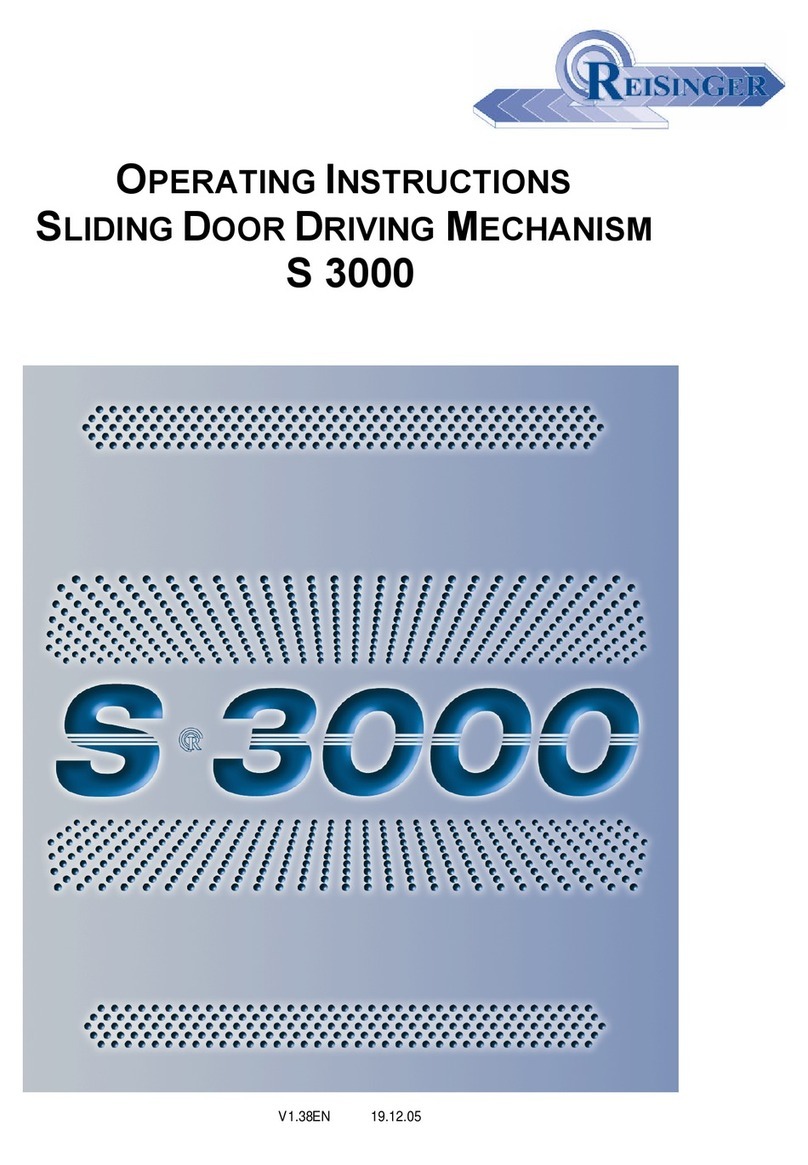
Reisinger
Reisinger S 3000 operating instructions
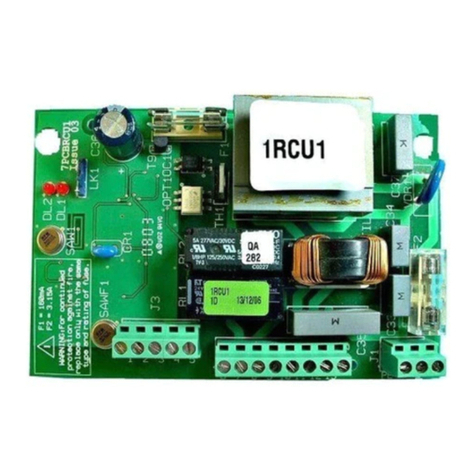
Genius
Genius RCU1 installation instructions
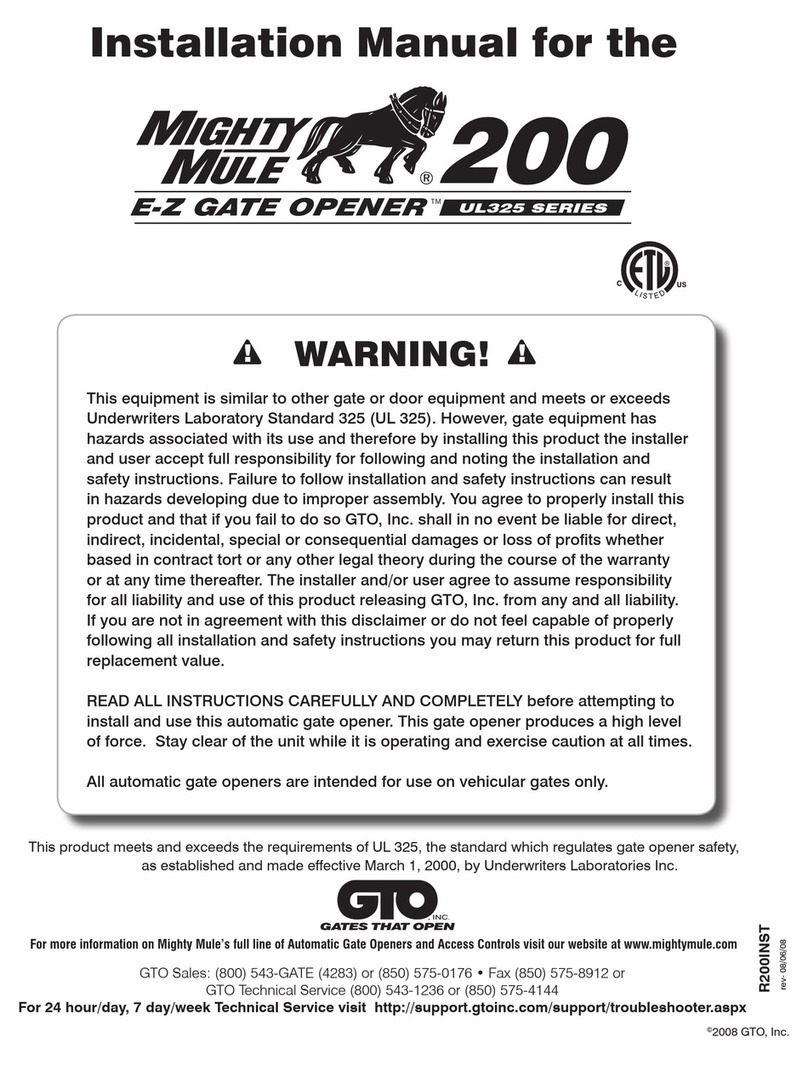
Mighty Mule
Mighty Mule 200 E-Z GATE OPENER UL325 SERIES installation manual
